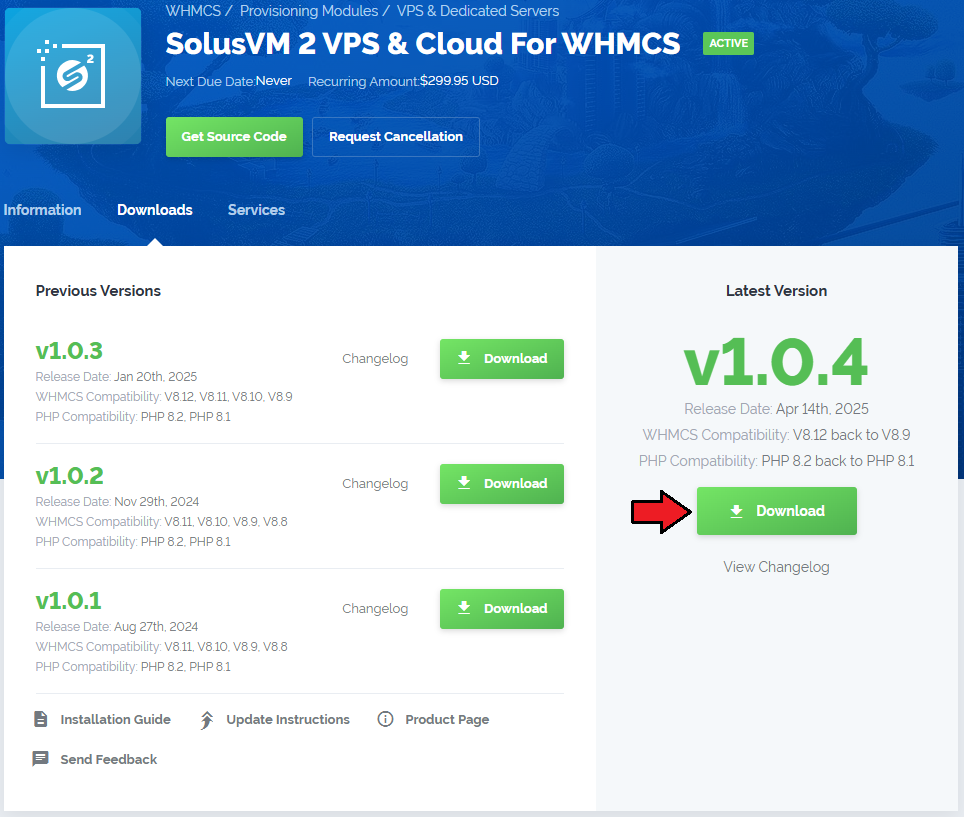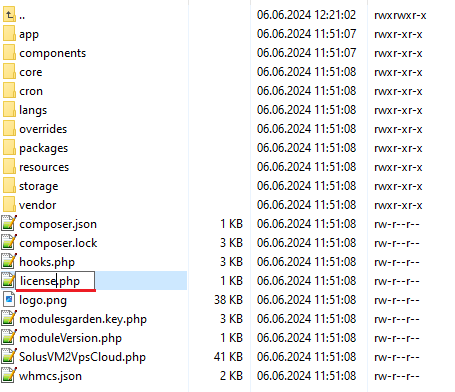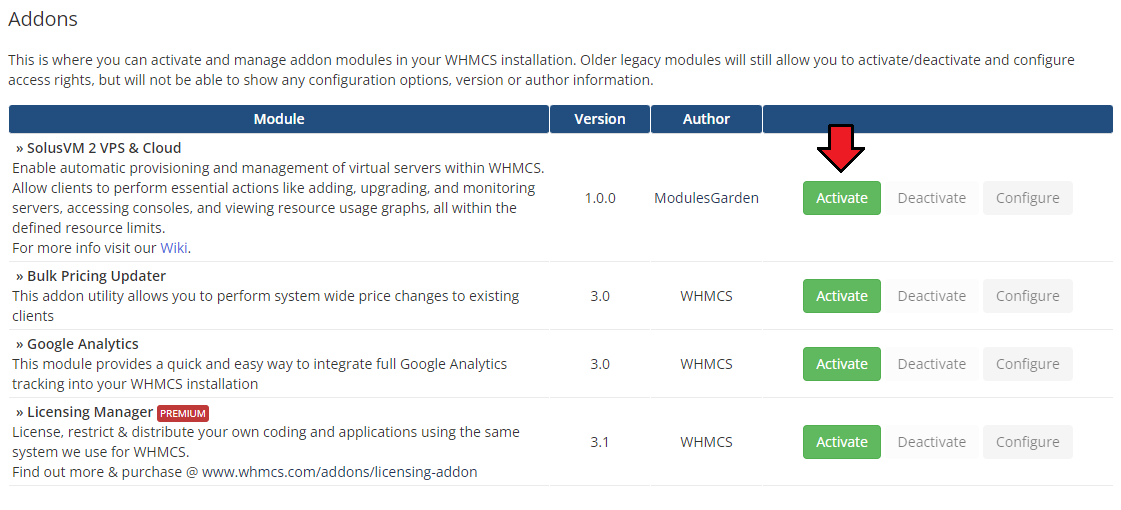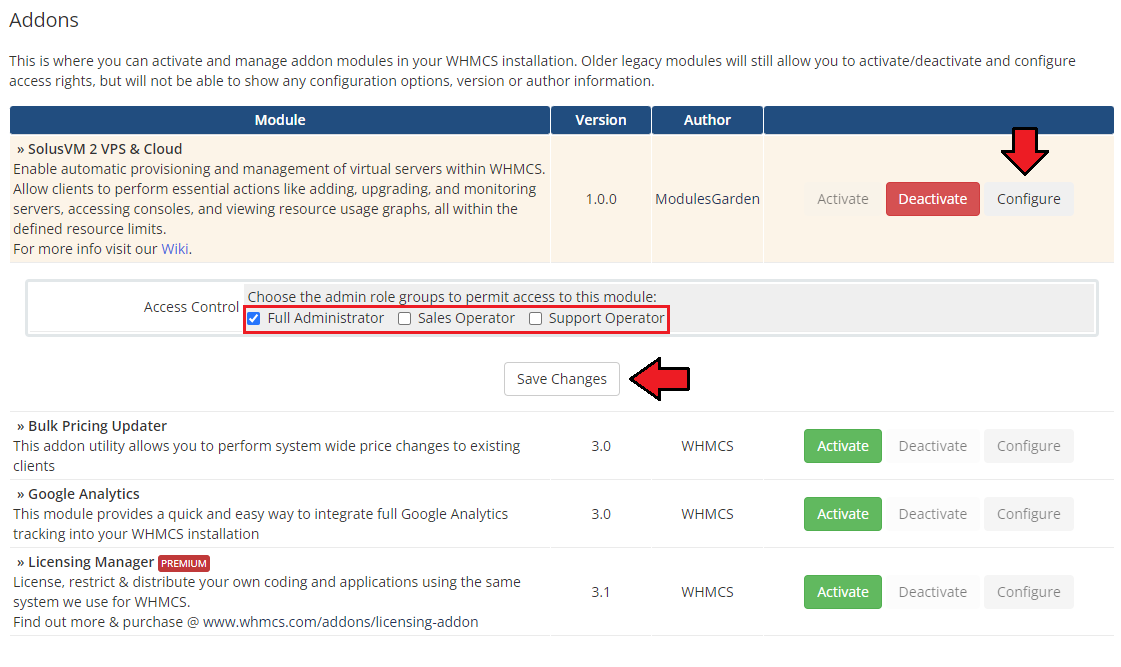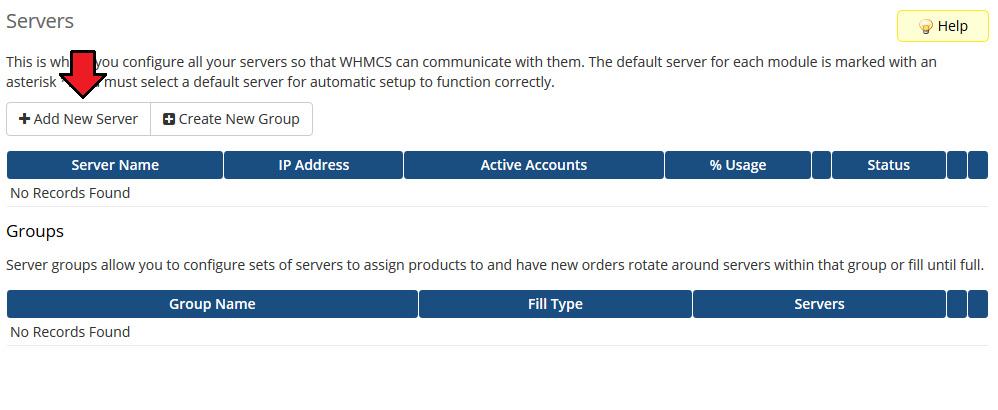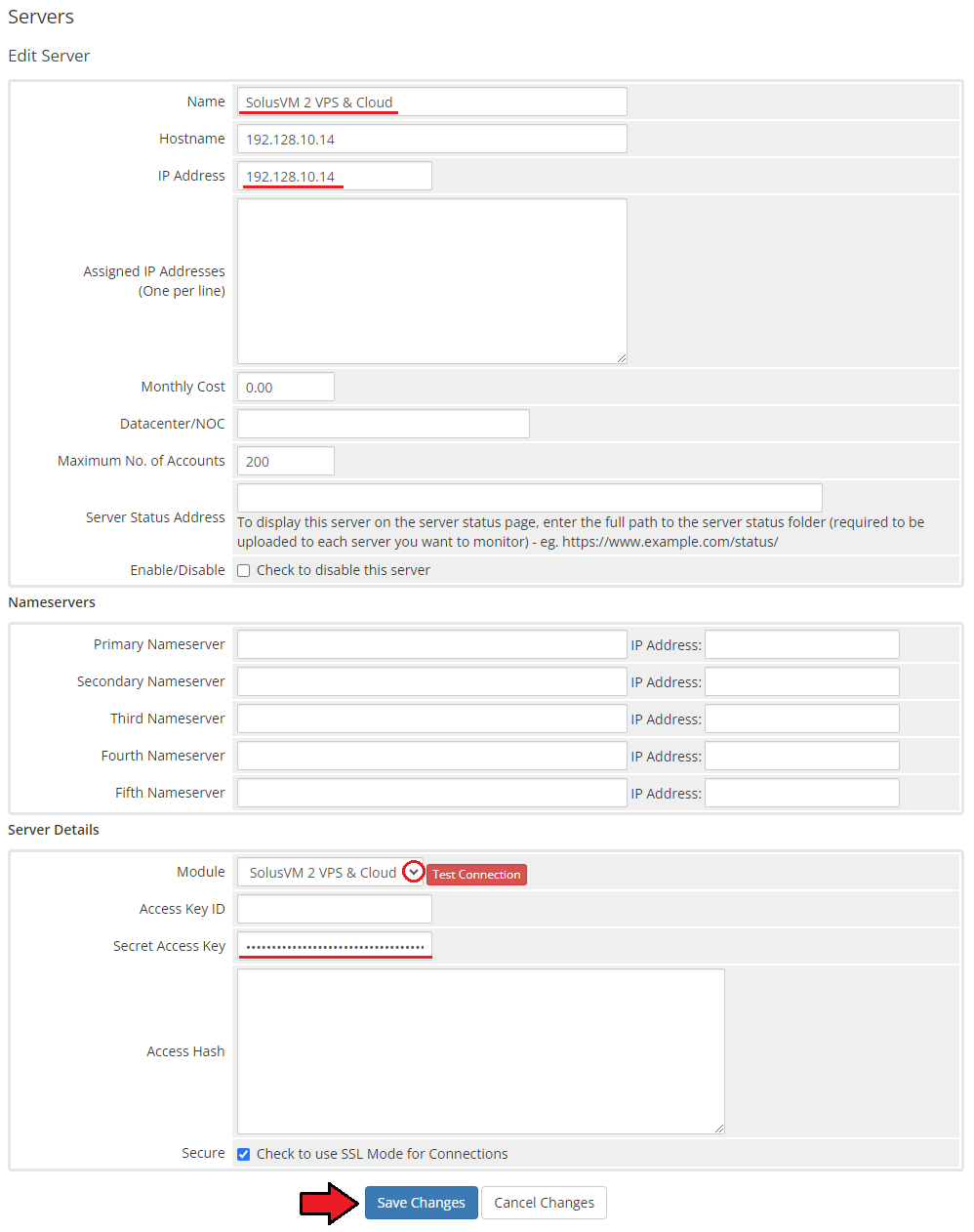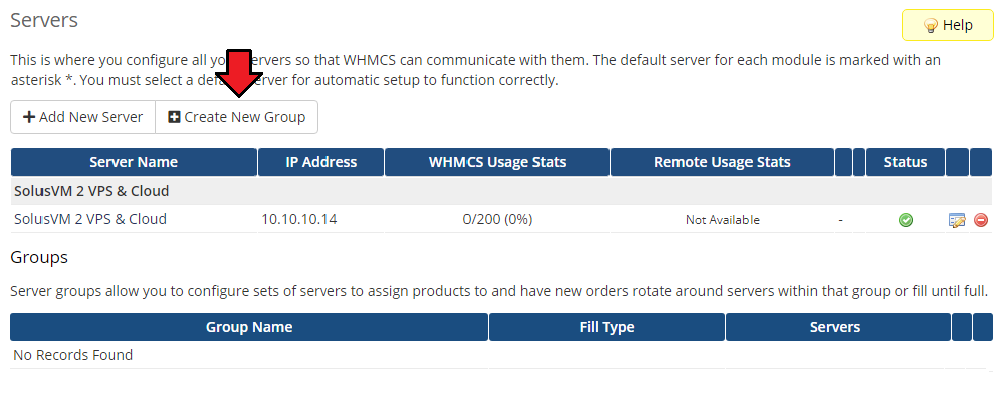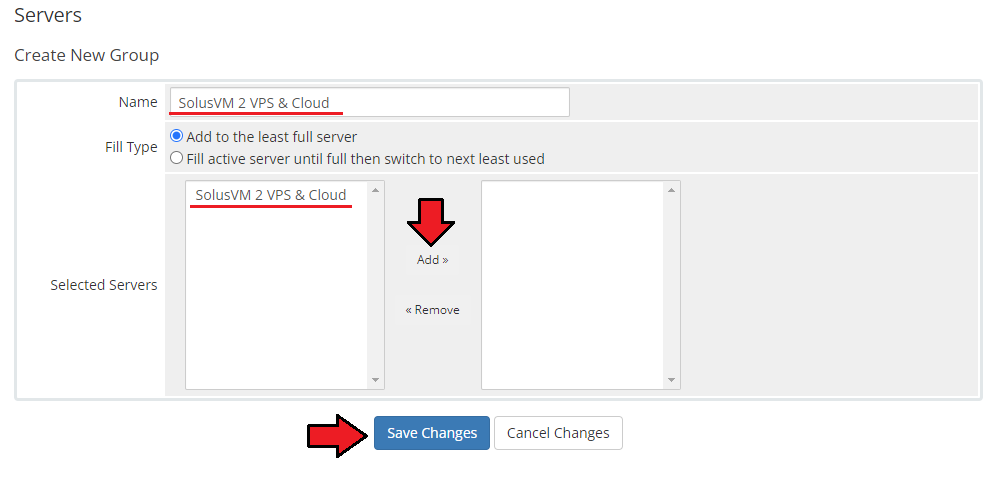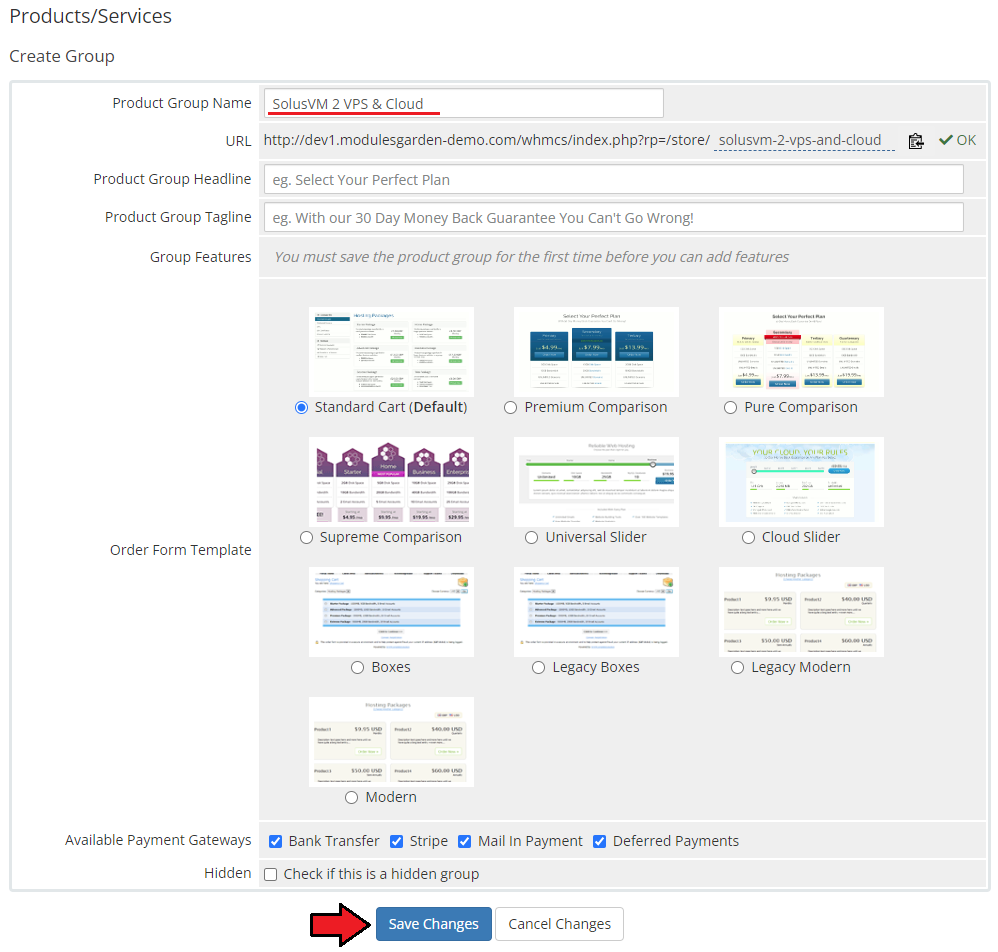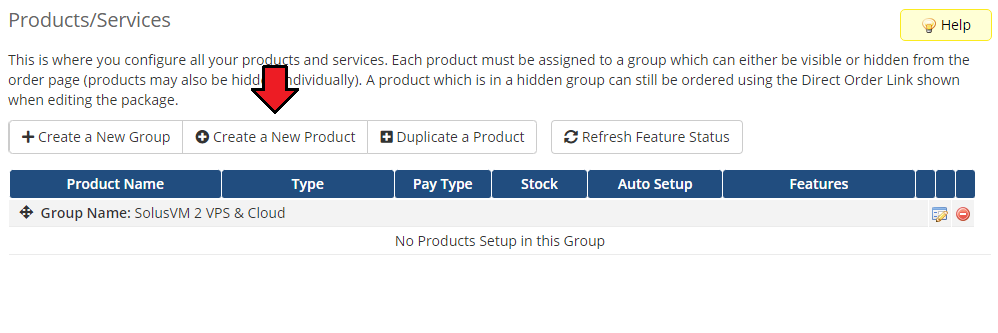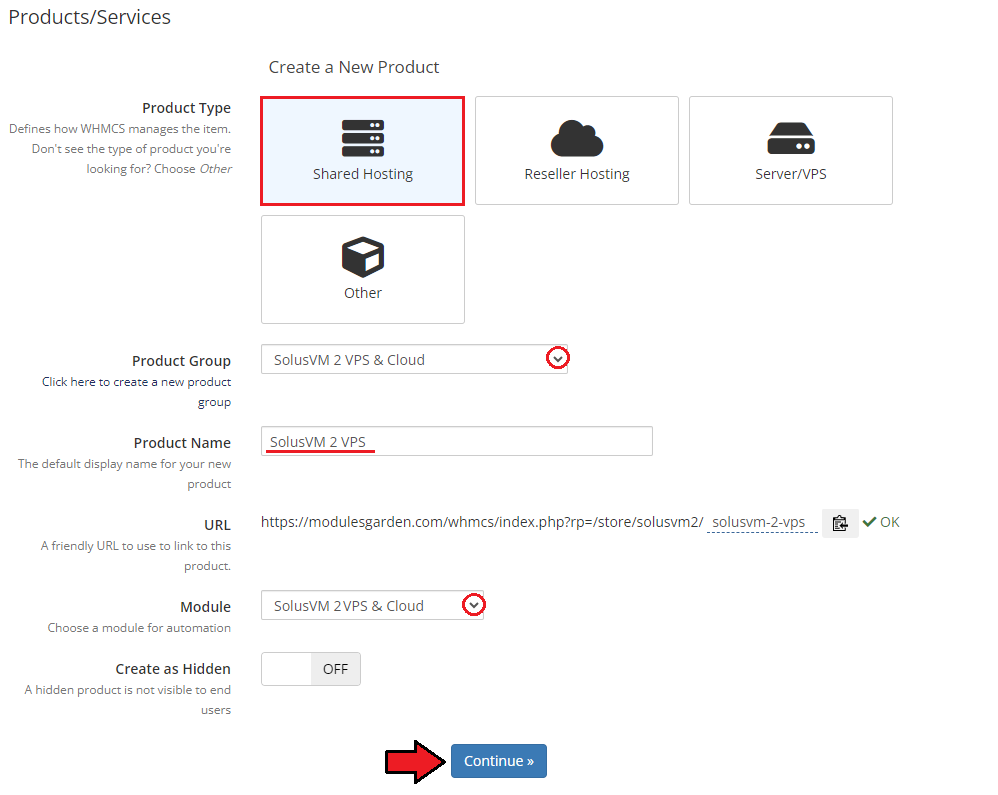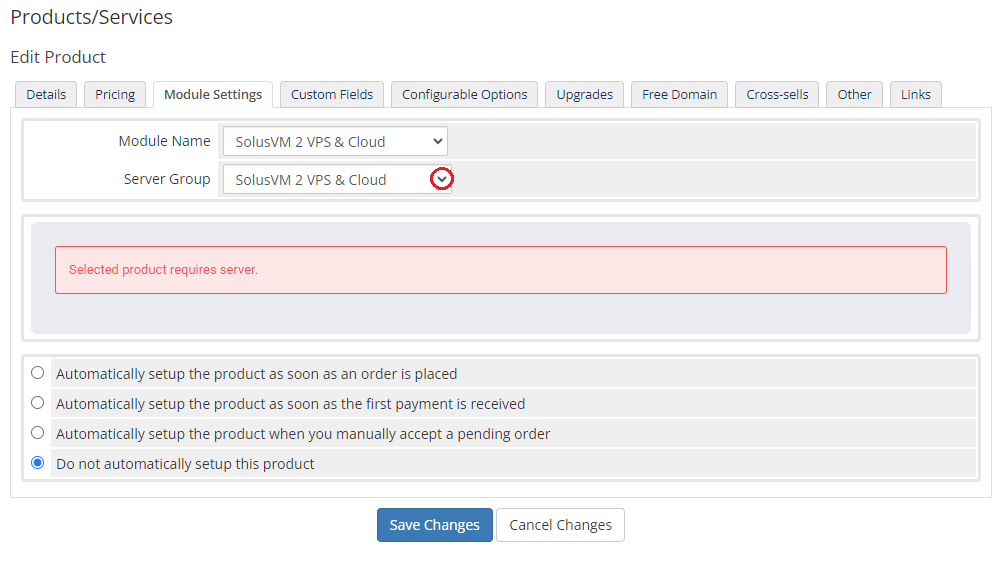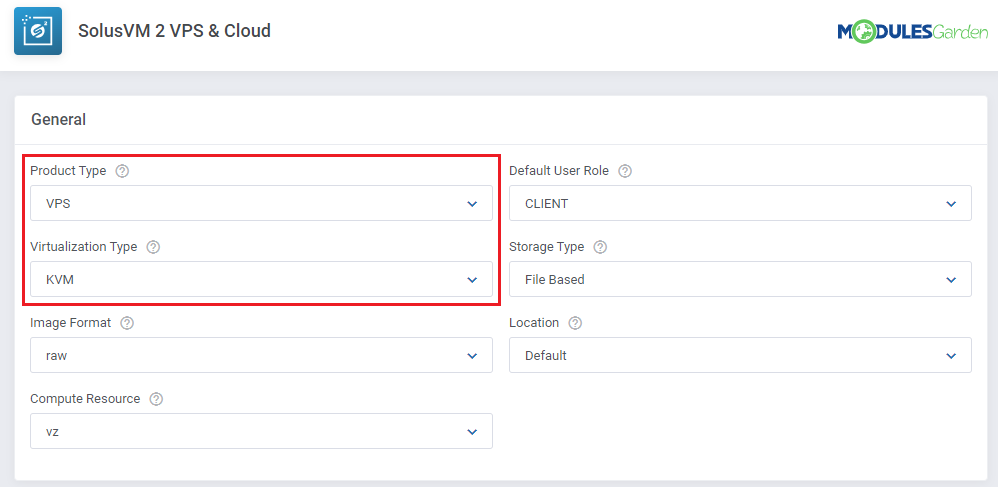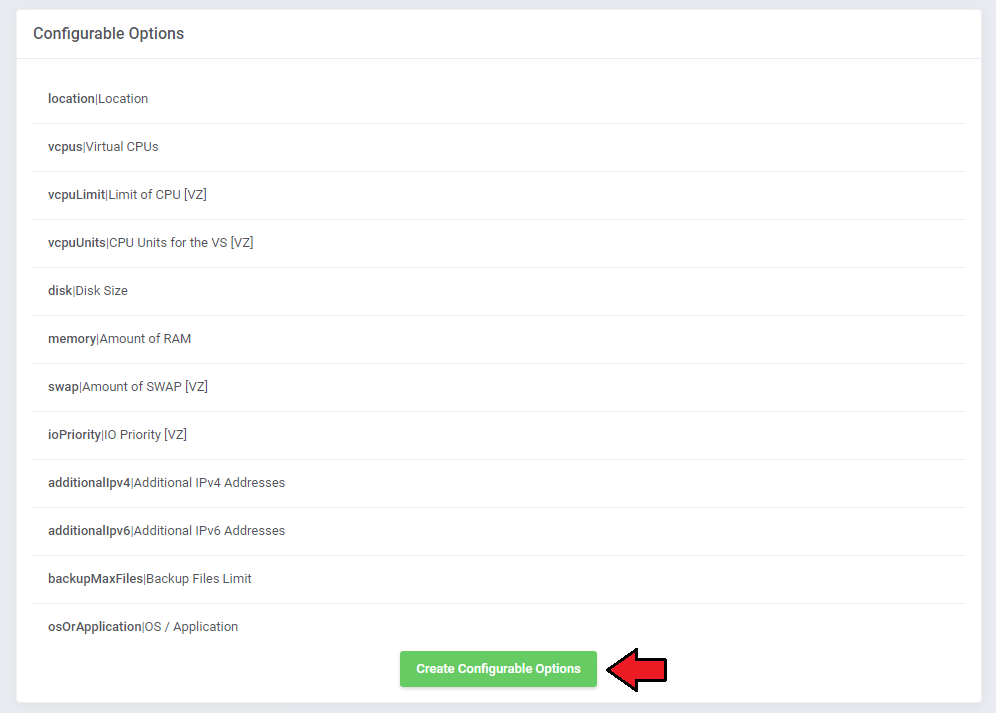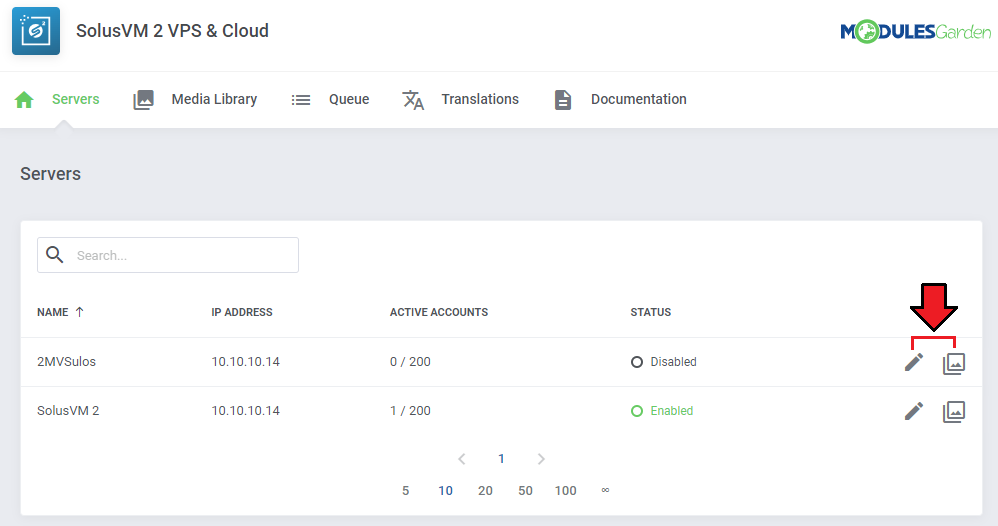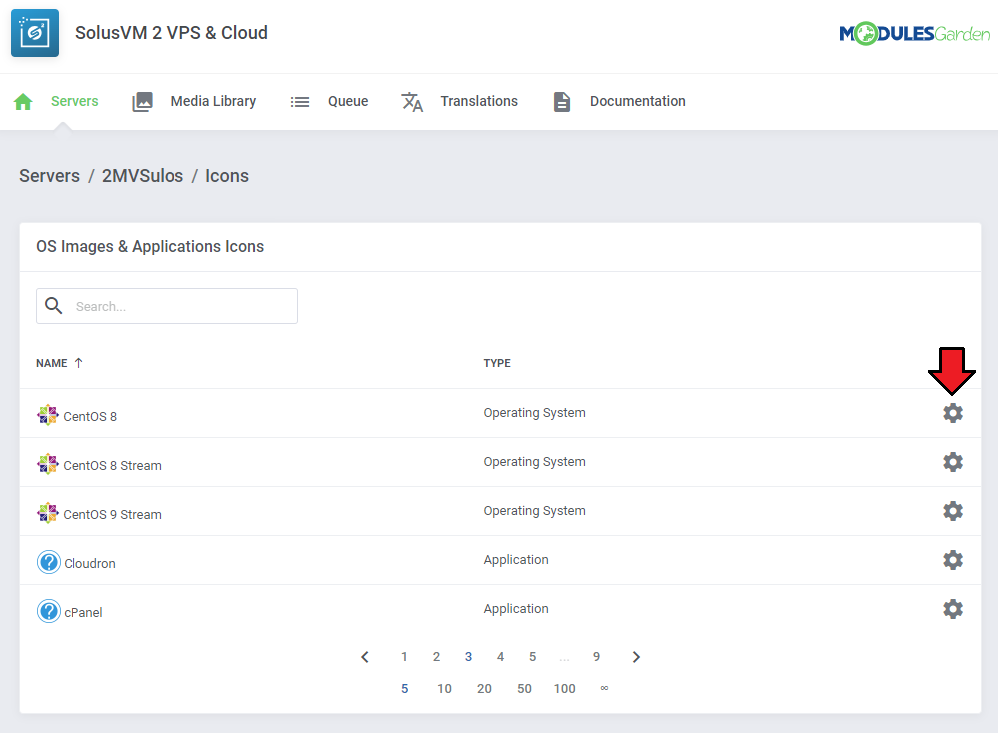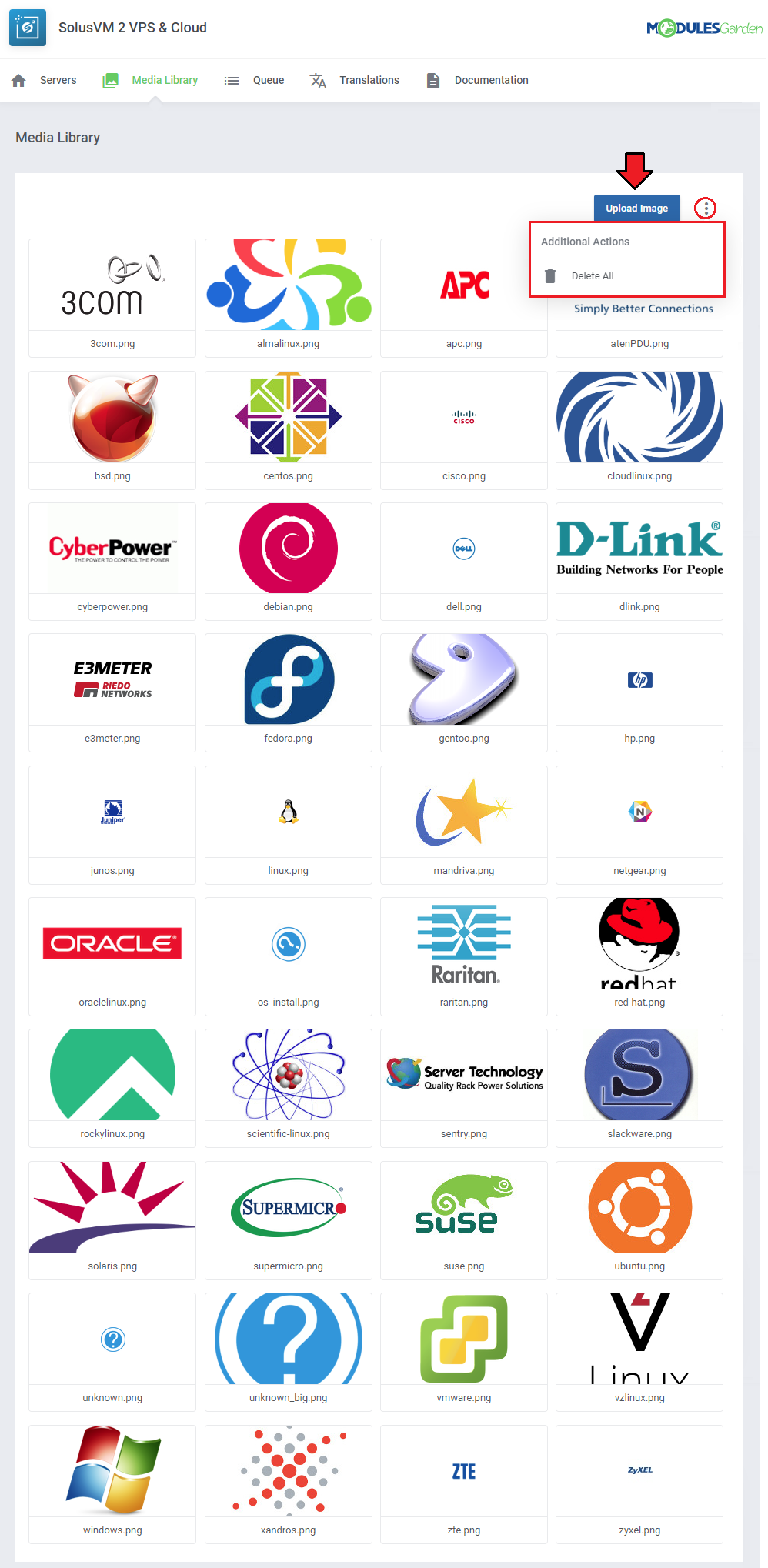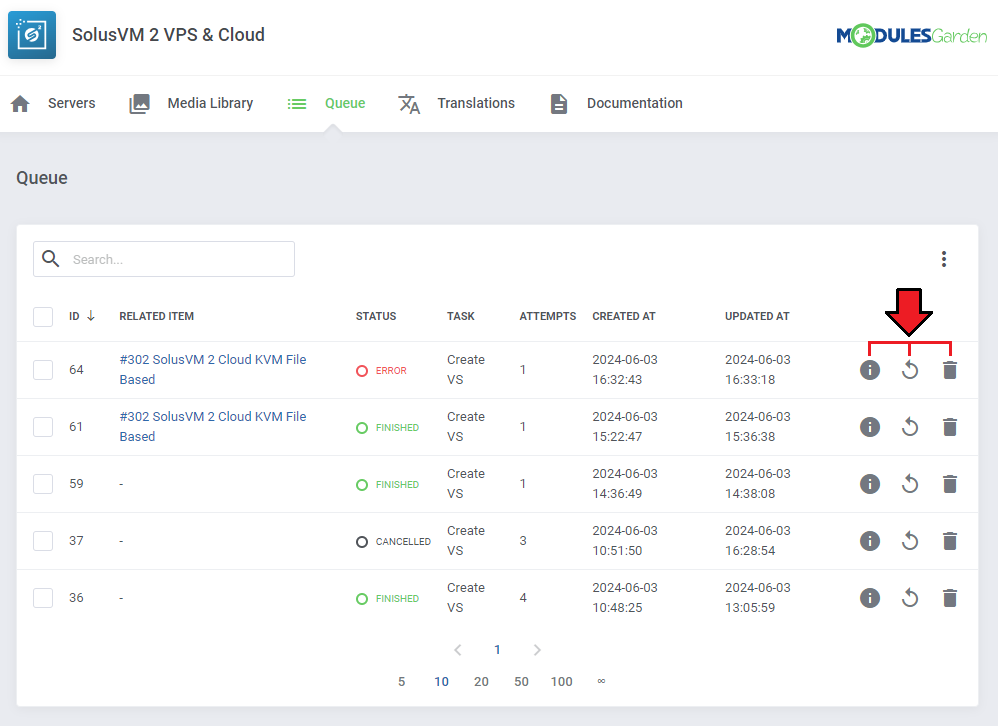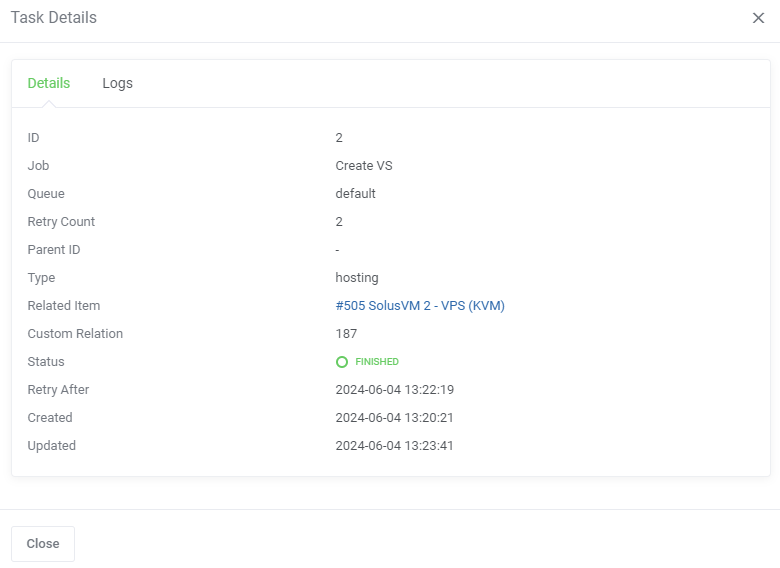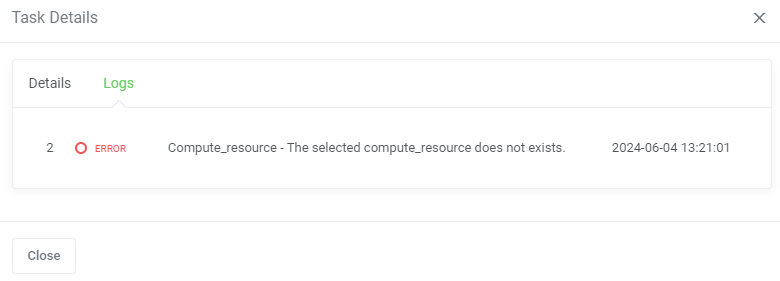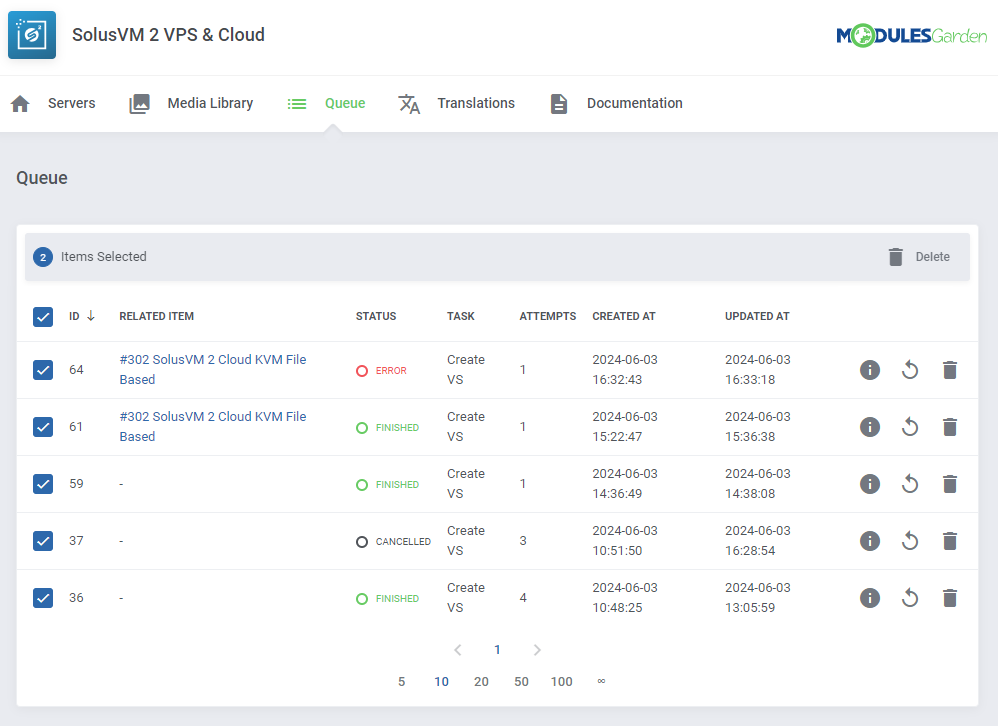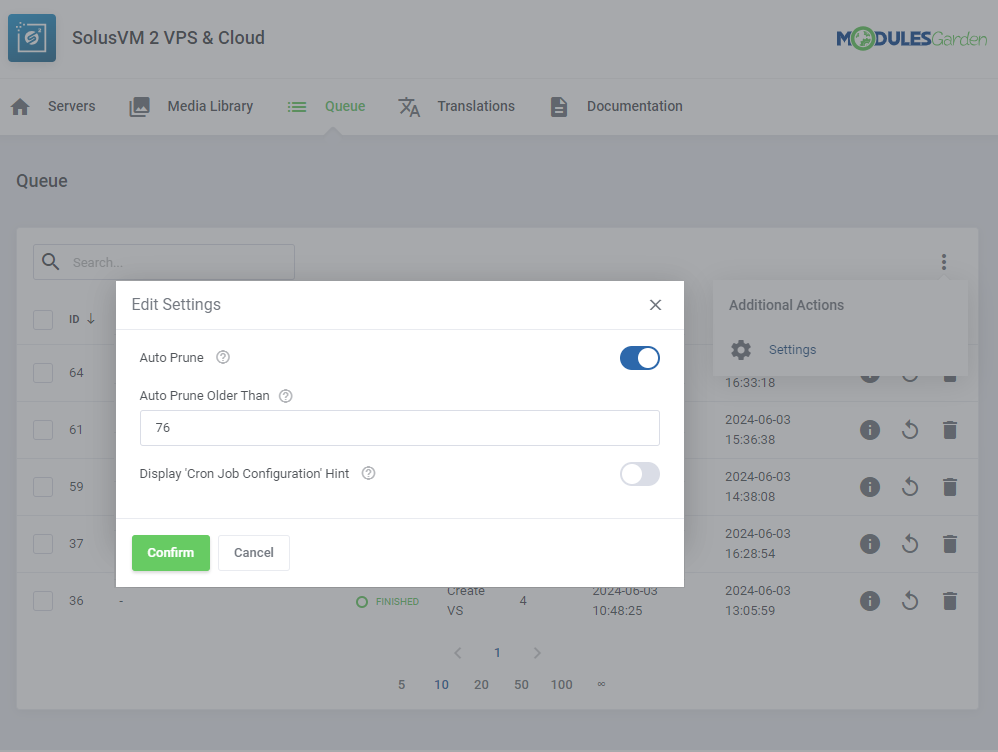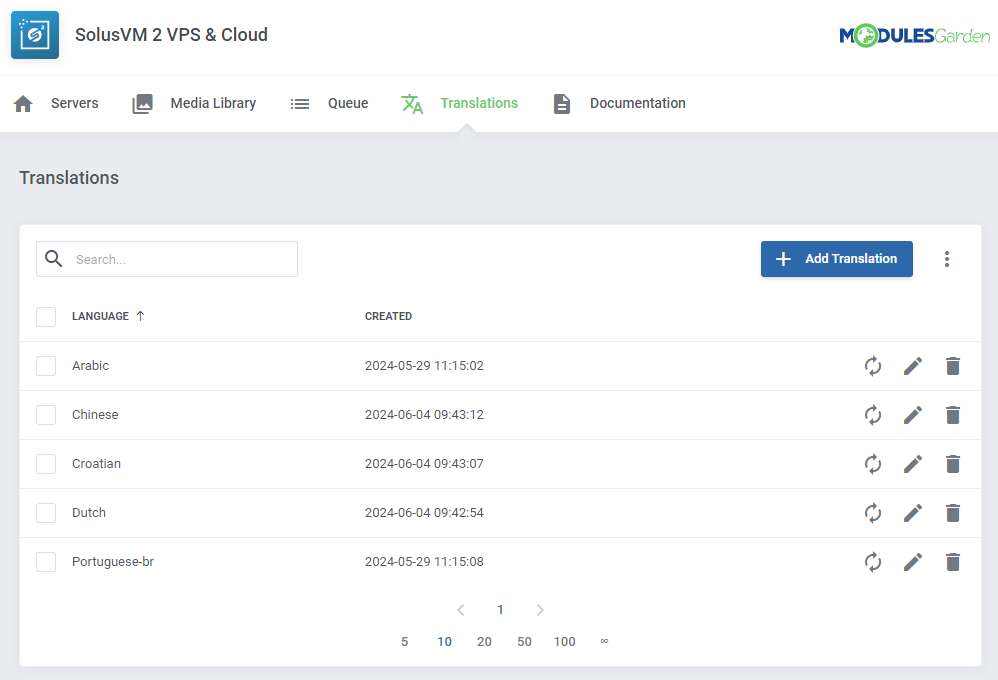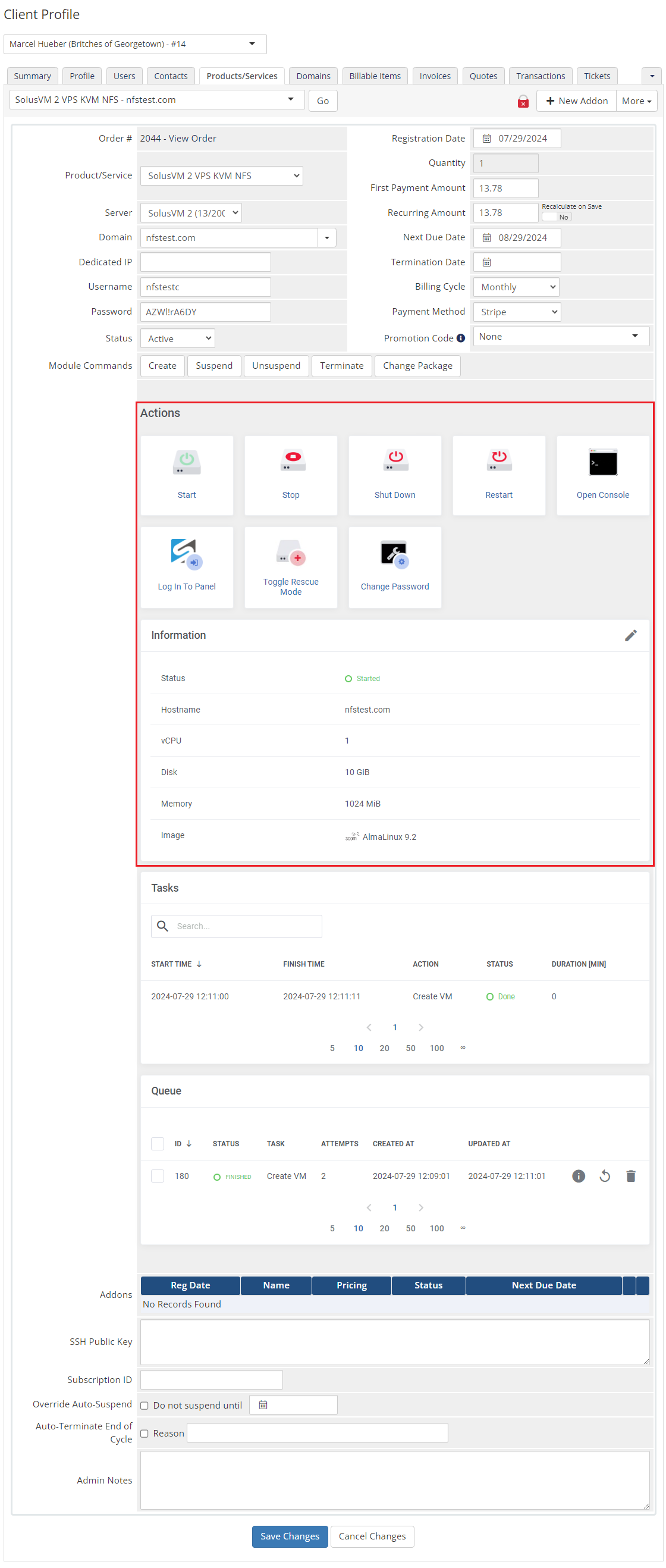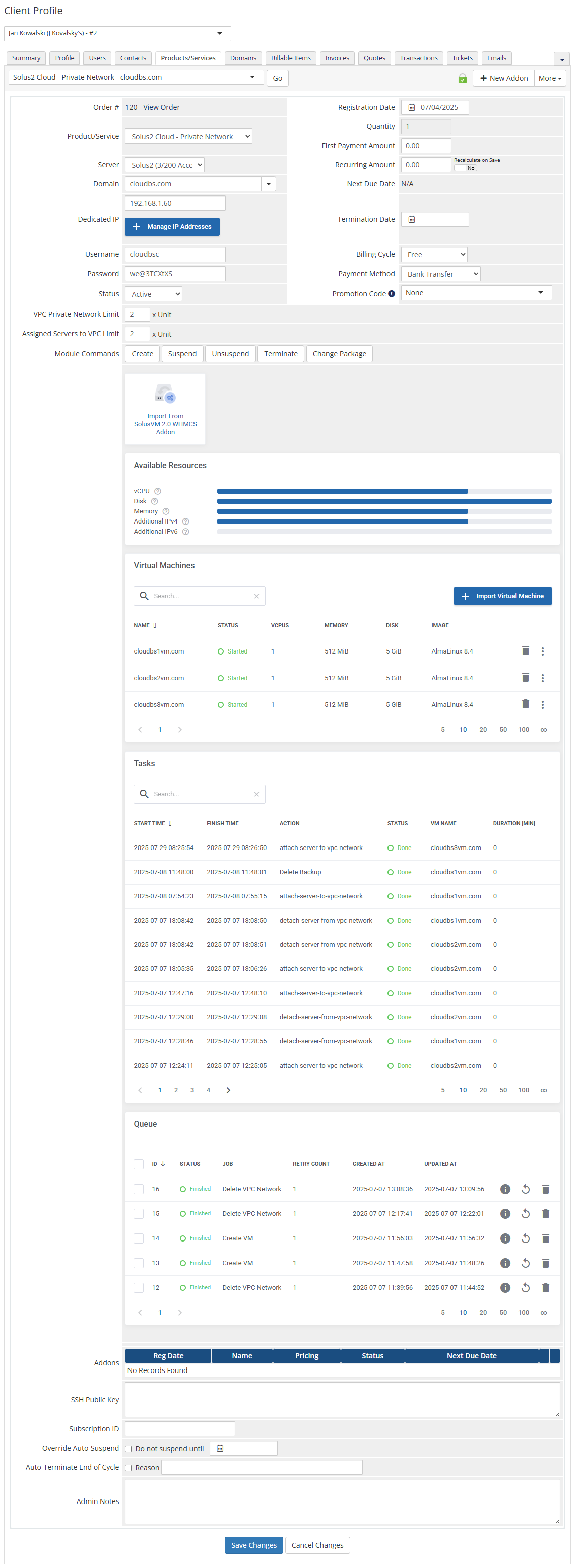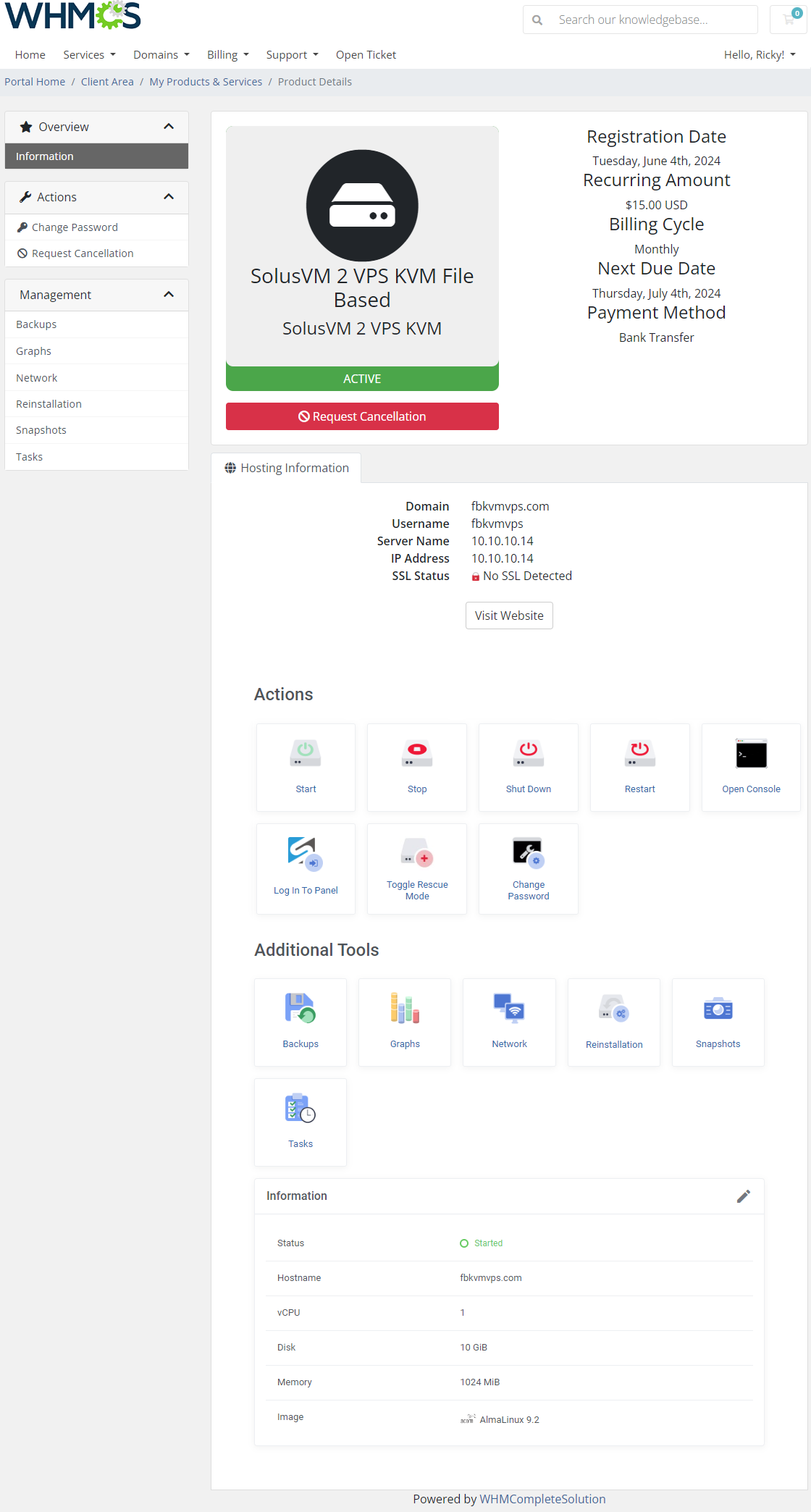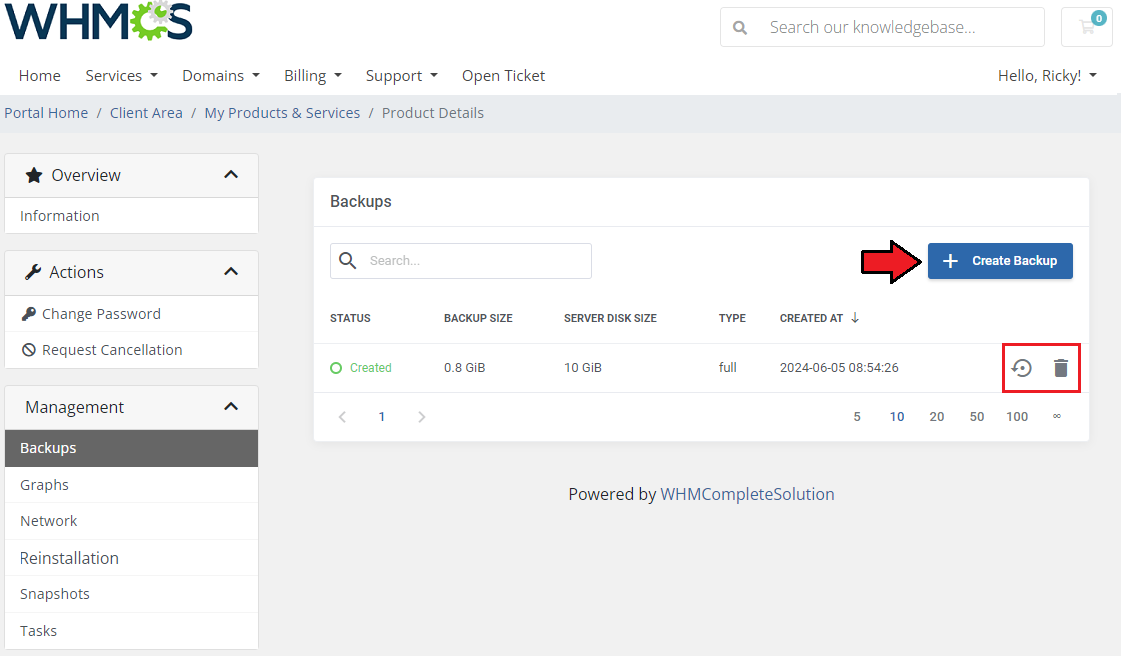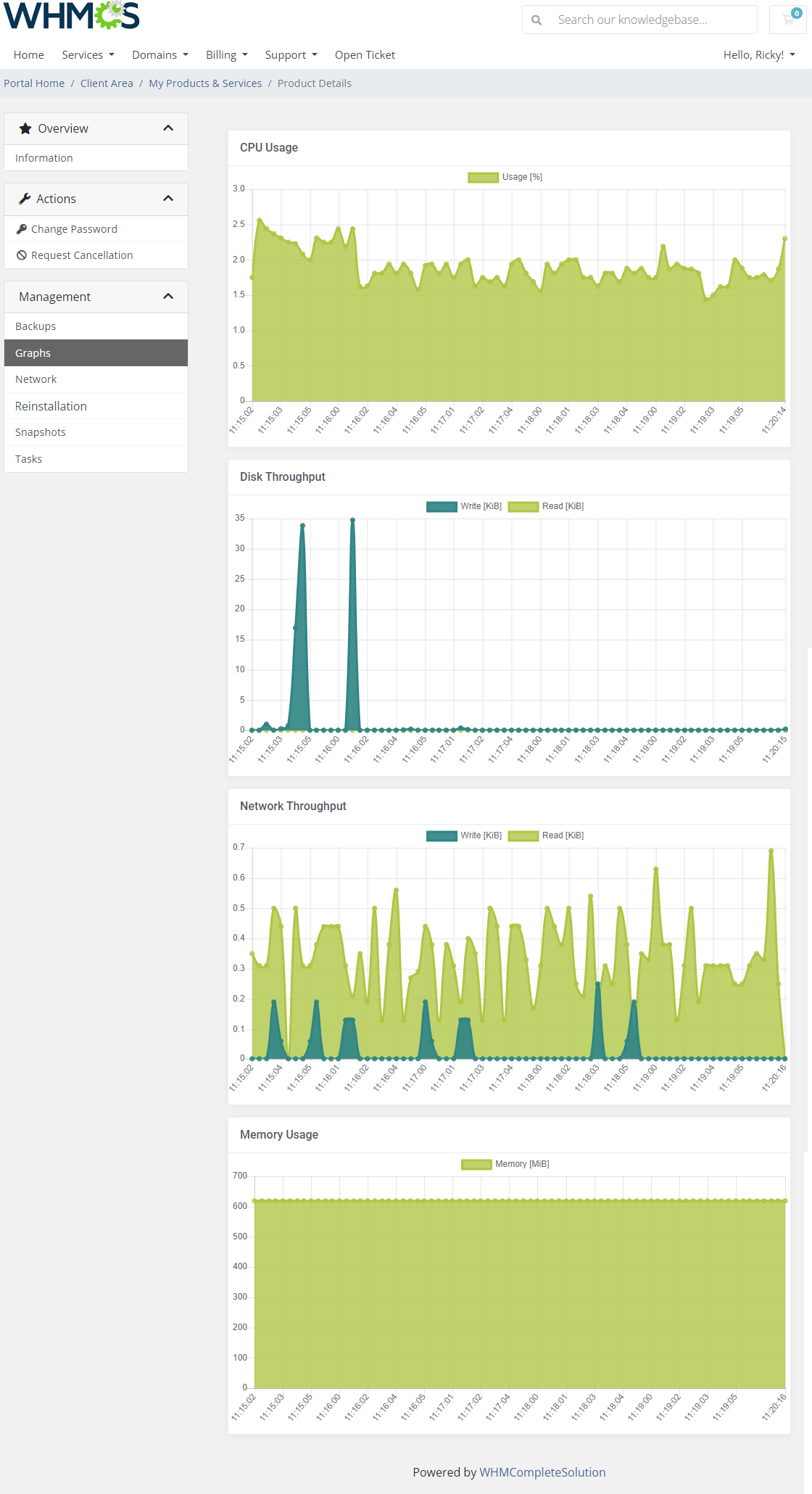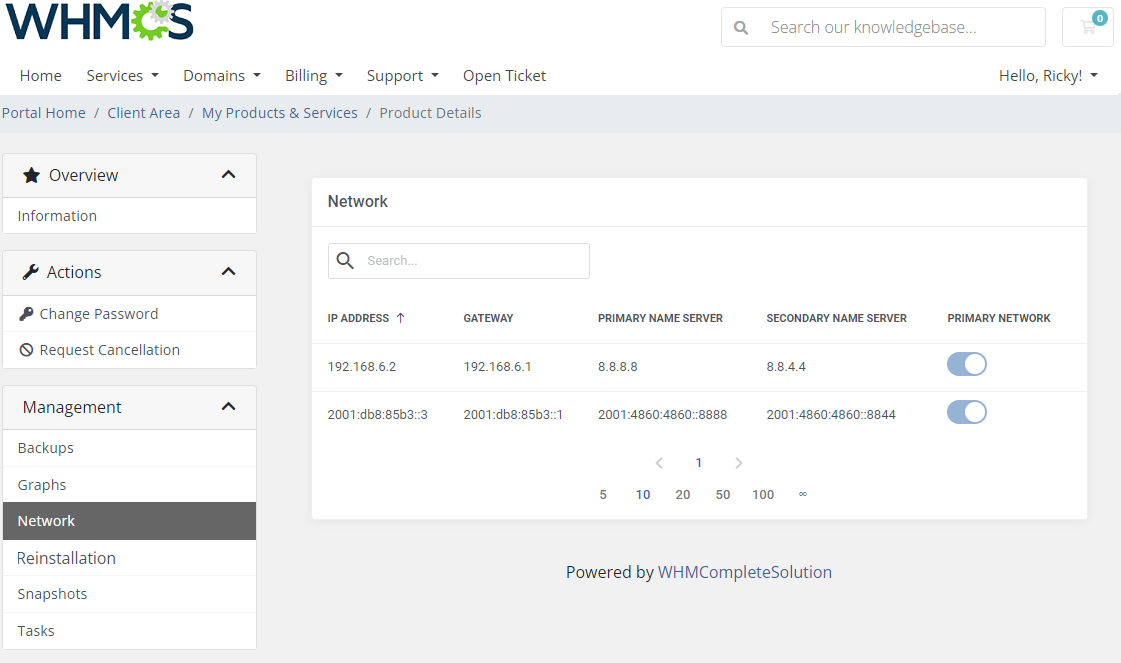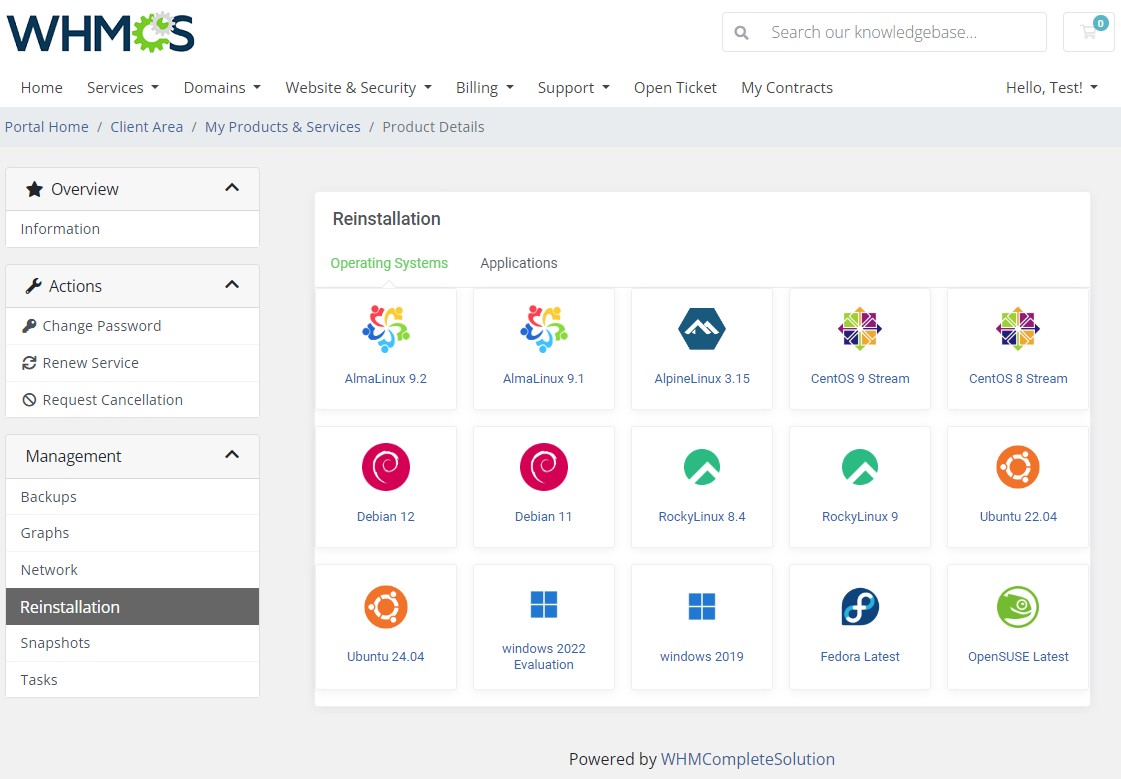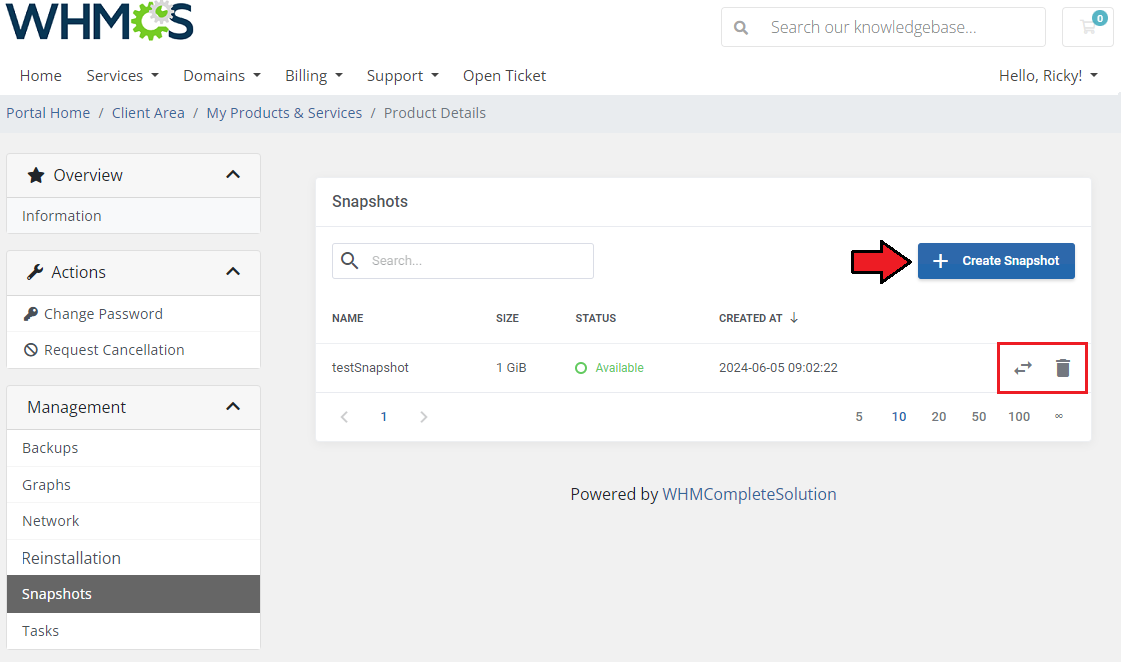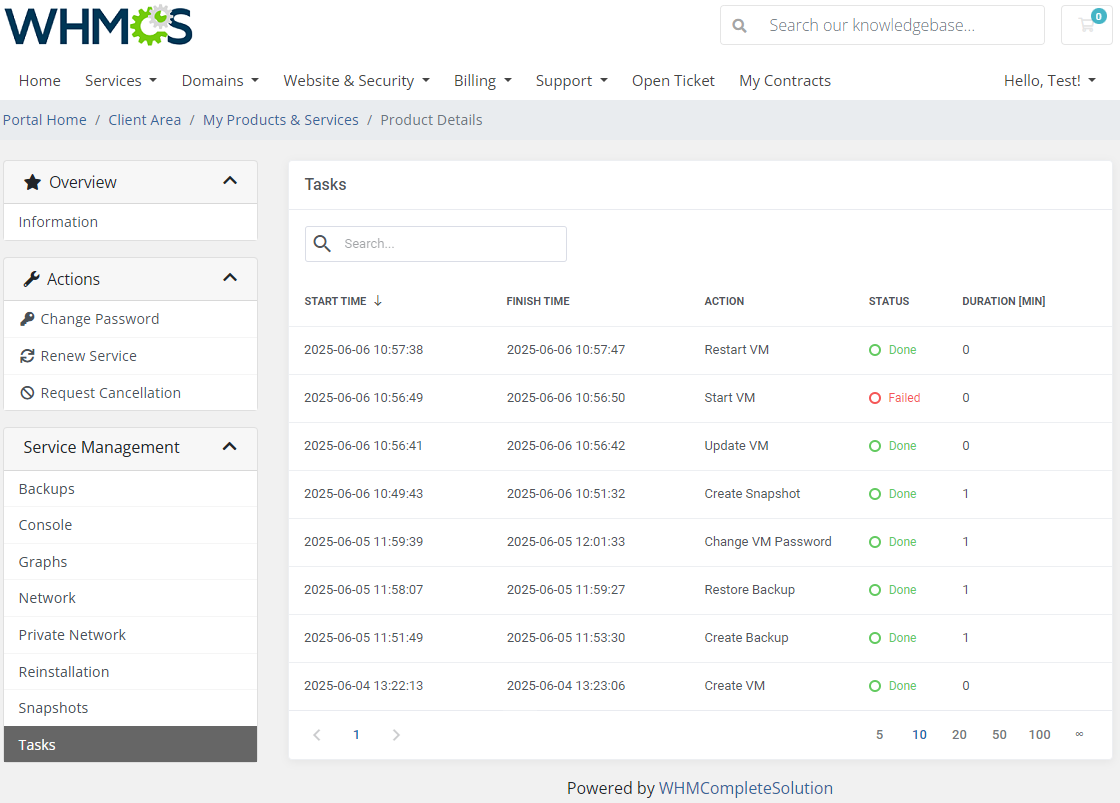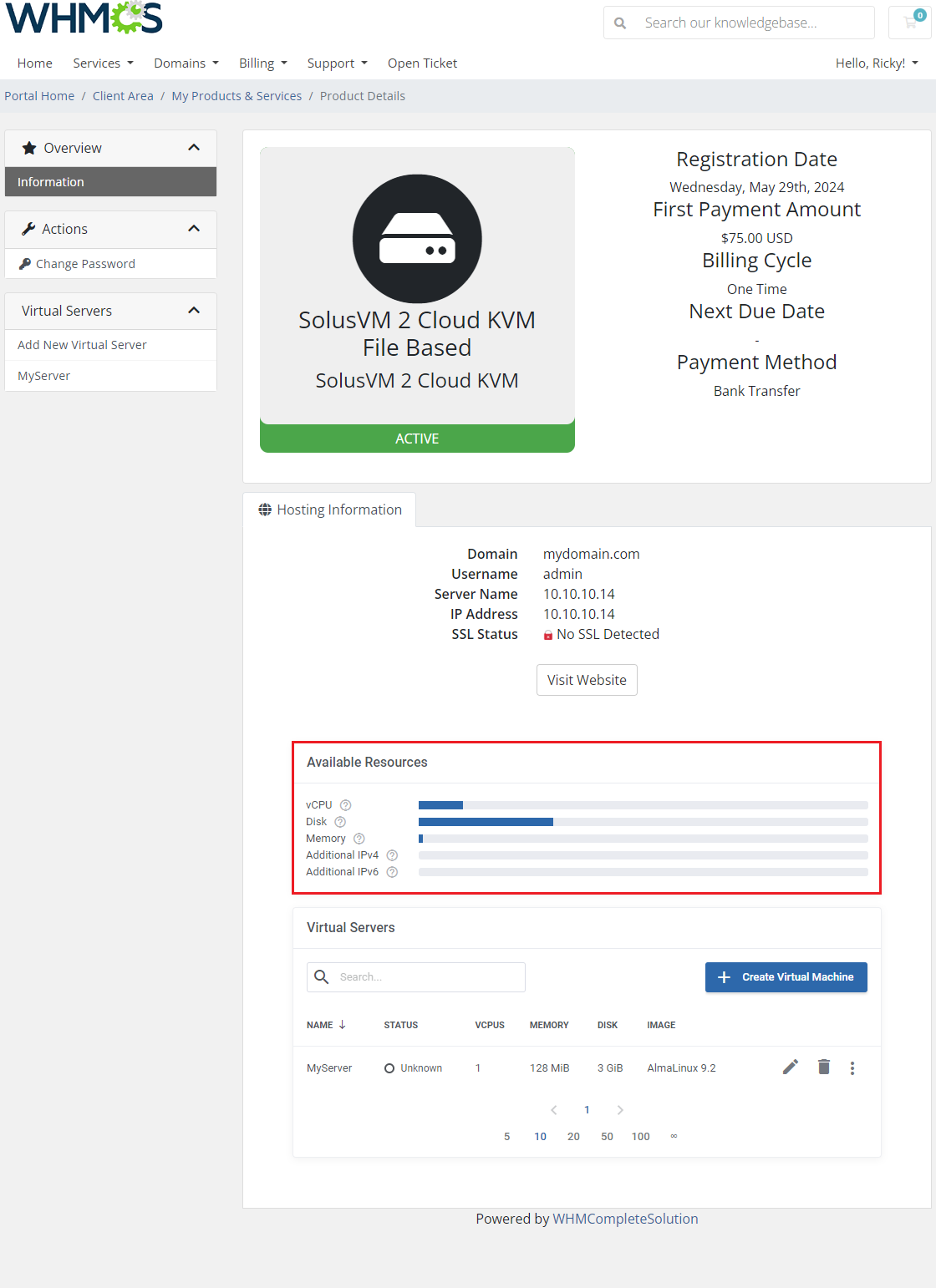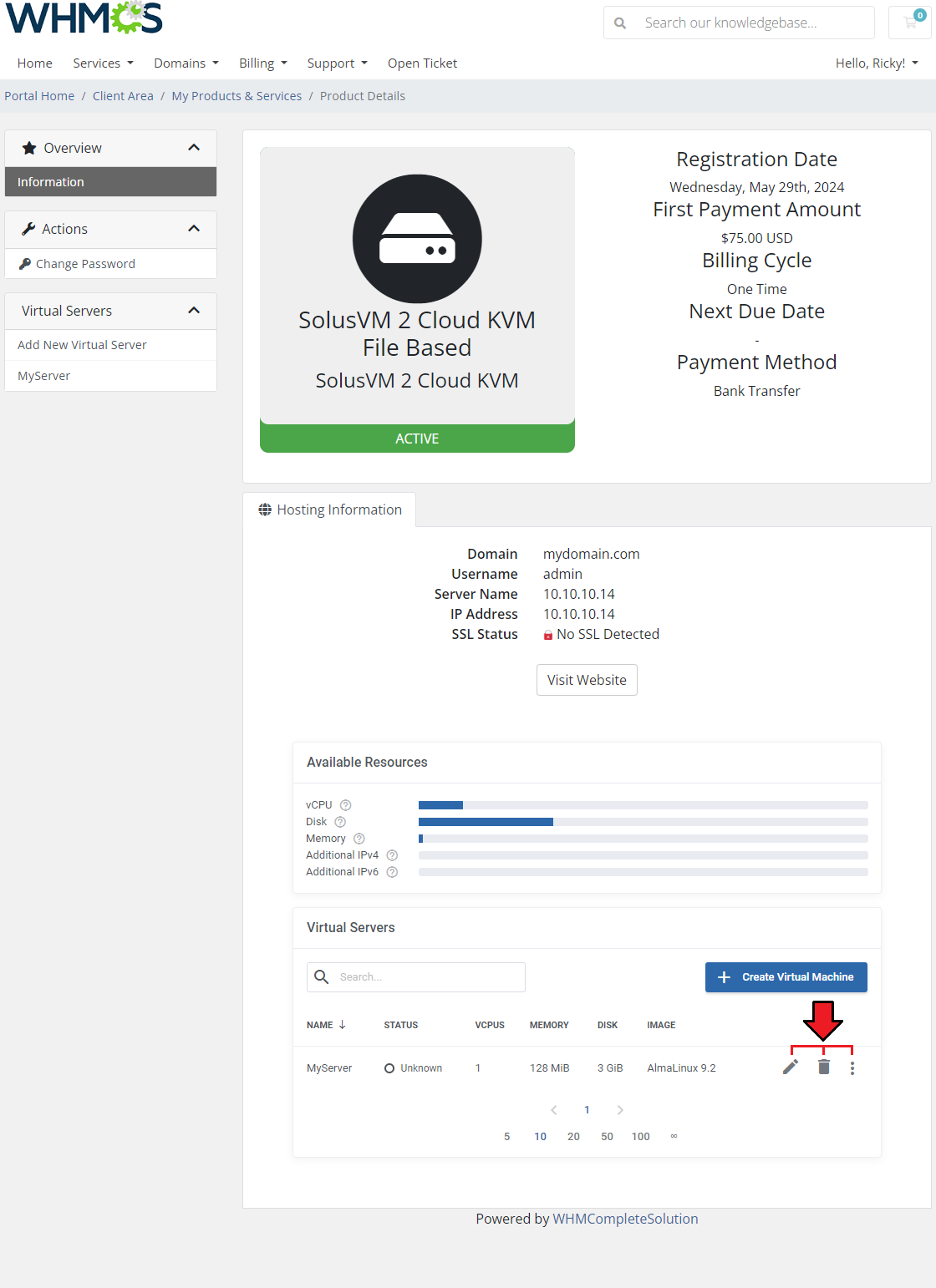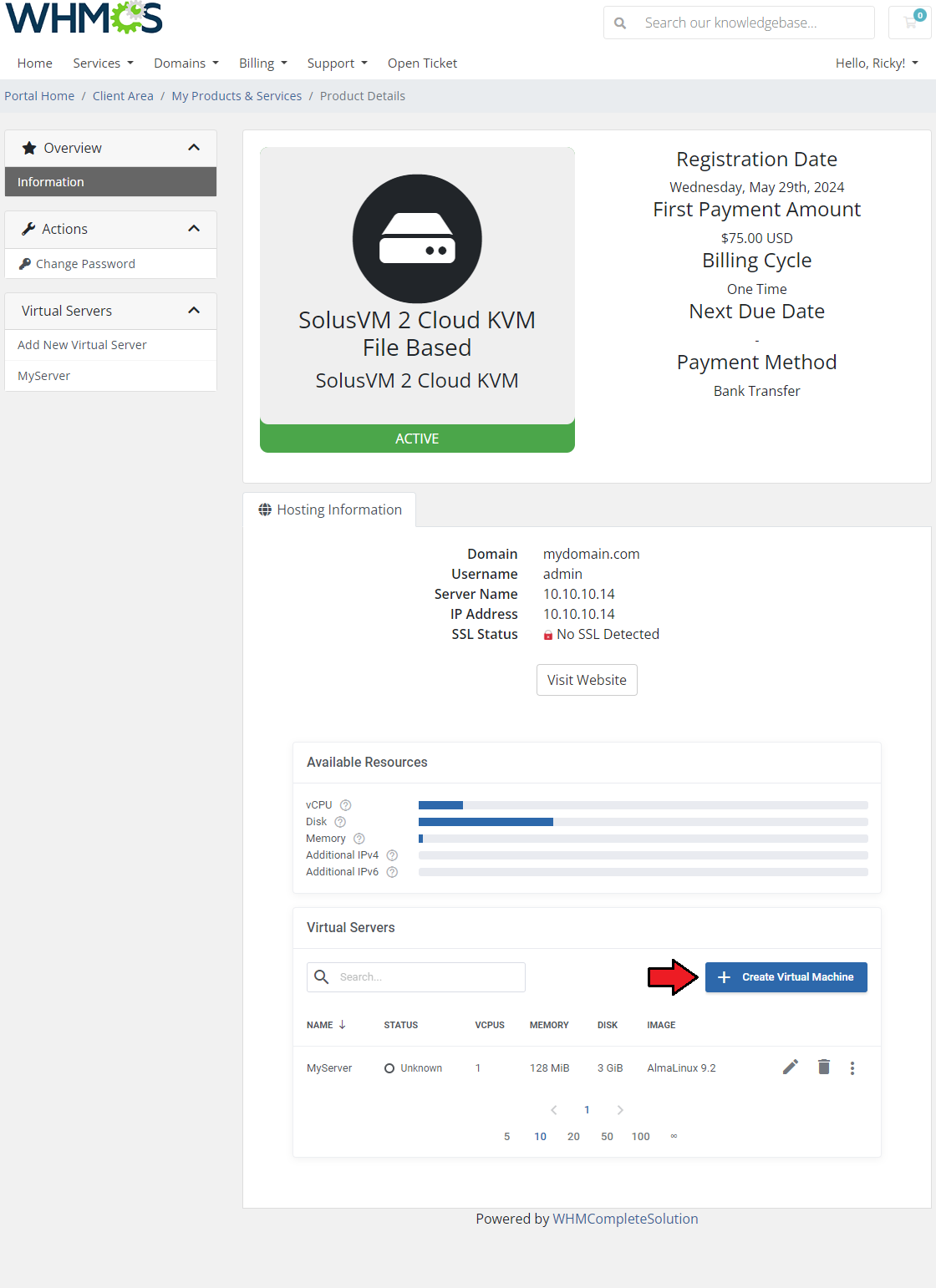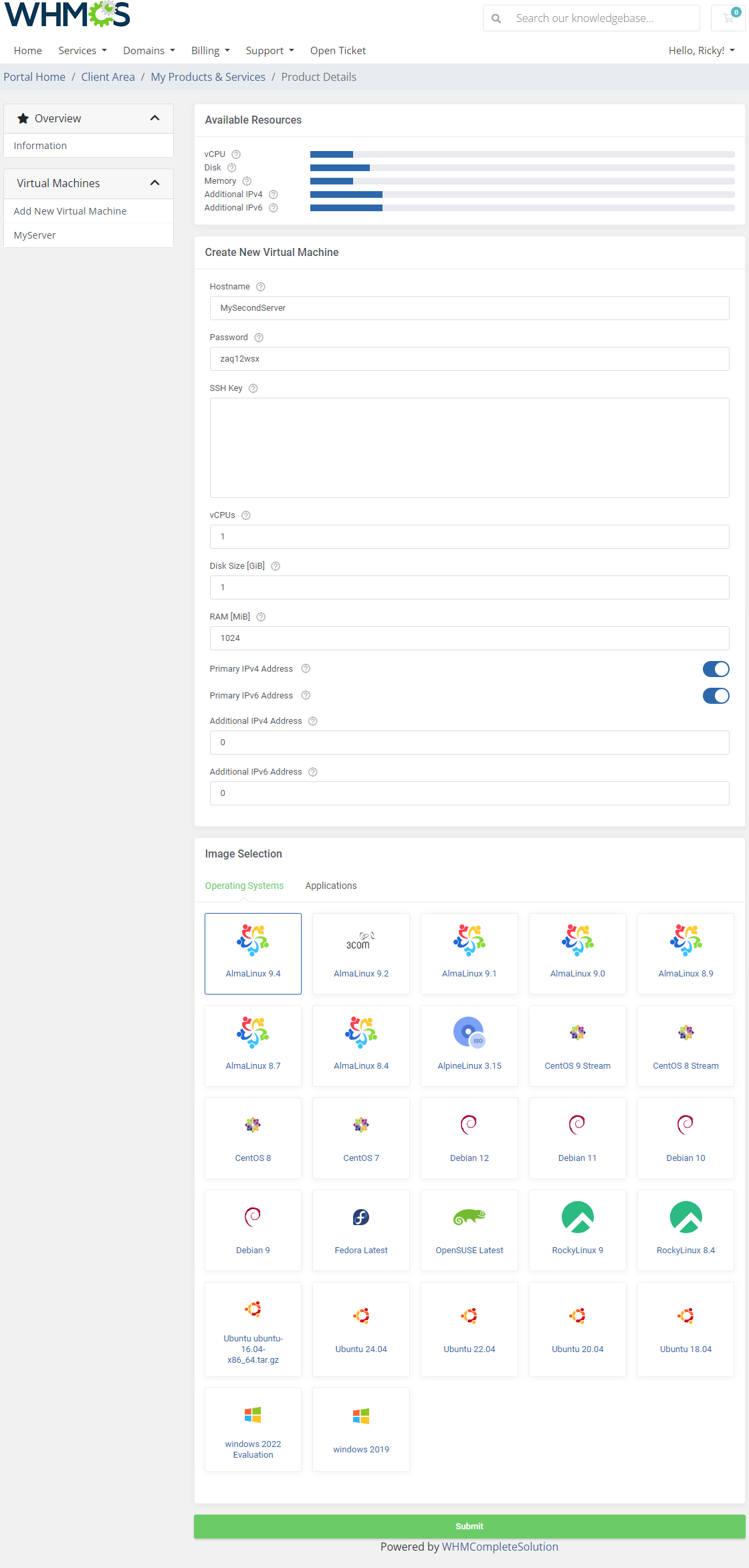SolusVM 2 VPS And Cloud For WHMCS
From ModulesGarden Wiki
(Difference between revisions)
|
|
| Line 326: |
Line 326: |
| | |} | | |} |
| | {| | | {| |
| − | |style="padding: 0px 0px 15px 15px;"|'''10. Enter your server name and IP address.'''<br/> | + | |style="padding: 0px 0px 15px 15px;"|'''10. Enter your server name and IP address.''' |
| − | Move down to '' 'Server Details'.''<br/>
| + | * Set the '''Module''' to '' 'SolusVM 2 VPS & Cloud For WHMCS'.'' |
| − | Choose '' 'SolusVM 2 VPS & Cloud For WHMCS' '' from a dropdown menu and provide:
| + | * Provide the '''Secret Access Key''' with your SolusVM 2 API token. <br/> '''''Important:''' Make sure the token is created for a user with the 'Admin' role. Some functions of the module might not work properly otherwise.''<br/> |
| − | *'''Password''' - fill in with your SolusVM 2 API token<br/>'''''Important:''' Make sure the token is created for a user with the 'Admin' role. Some functions of the module might not work properly otherwise.''<br/> | + | |
| − | Other fields are not obligatory.<br/>
| + | Check '''Secure''' option if your server uses an SSL connection.<br/> |
| − | Check if your server uses an SSL connection.<br/> | + | You may test the connection by clicking on the dedicated button if successful, press '' 'Save Changes' '' to complete the server configuration. |
| − | You may test the connection by clicking on the dedicated button.<br/> | + | |
| − | Press '' 'Save Changes' '' when ready.
| + | |
| | |} | | |} |
| | {| | | {| |
Revision as of 11:36, 6 June 2024
SolusVM 2 VPS & Cloud For WHMCS module offers provisioning of virtual machines as single VPS instances or flexible Cloud resources.
Allow your clients to create and manage servers within their limits using efficient tools for backups, snapshots, reinstallations, and real-time performance monitoring.
Use the module to Empower your customers with comprehensive control over their virtual servers.
|
| ✔ Create/Suspend/Unsuspend/Terminate Server
|
| ✔ Start/Stop/Pause/Unpause/Resume Server
|
| ✔ View Server Status And Details
|
| ✔ View Scheduled And Completed Tasks
|
| ✔ Provide Product General Configuration:
|
| ✔ VPS - Provisioning Of Single Server Per Product
|
| ✔ Cloud - Enable Provisioning Of Multiple Servers Per Single Product
|
| ✔ Select Virtualization Type:
|
| ✔ Select Compute Resource
|
| ✔ Select Default User Role
|
| ✔ Additional IPv4 Addresses
|
| ✔ Additional IPv6 Addresses
|
| ✔ Define Default Server Configuration:
|
| ✔ Provide User Data Script
|
| ✔ Select Default Operation System / Application
|
| ✔ Enable Access To Client Area Features:
|
| ✔ Select Available Operation Systems
|
| ✔ Select Available Applications
|
| ✔ Generate Configurable Options
|
| ✔ View Server Configurations Lists And Details:
|
| ✔ Customize Operation System And Application Logo Images
|
| ✔ View Queue Of Scheduled Tasks And Details
|
| ✔ Customize Module Language Files With "Translations" Tool
|
| ✔ View Server Status And Details
|
| ✔ Start/Stop/Restart Server
|
| ✔ Create/Manage/Restore Backups
|
| ✔ Reinstall Server Using:
|
| ✔ Create/Manage/Restore Snapshots
|
| ✔ View Scheduled And Completed Tasks
|
| ✔ Additional IPv4 Addresses
|
| ✔ Additional IPv6 Addresses
|
| ✔ Supports PHP 8.1 Back To PHP 7.4
|
| ✔ Supports WHMCS Themes "Six", "Twenty-One" And "Lagom WHMCS Client Theme"
|
| ✔ Supports WHMCS V8.10 Back To WHMCS V8.8
|
| ✔ Requires ionCube Loader V12 Or Later
|
Installation and Configuration
In this tutorial we will show you how to successfully install SolusVM 2 VPS & Cloud For WHMCS.
We will guide you step by step through the whole installation and configuration process.
|
| 1. Log in to our client area and download the module.
|
3. Extract the package and upload its content into the main WHMCS directory.
The content of the package to upload should look like this.
|
4. When you install SolusVM 2 VPS & Cloud For WHMCS for the first time you have to rename 'license_RENAME.php' file.
File is located in '/modules/servers/SolusVM2VpsCloud/license_RENAME.php'. Rename it from 'license_RENAME.php' to 'license.php'.
|
5. In order to configure your license key, you have to edit a previously renamed 'license.php' file.
Enter your license key between quotation marks as presented on the following screen. You can find your license key in our client area → 'My Products'.
|
6. In the next step, set up the 'storage' folder as recursively writable.
This folder is available at 'your_whmcs/modules/servers/SolusVM2VpsCloud/storage'.
|
Activation of SolusVM 2 VPS & Cloud Addon
7. Firstly, activate the SolusVM 2 VPS & Cloud addon.
To do so, log in to your WHMCS and navigate to 'System Settings' →'Addon Modules'. Find 'SolusVM 2 VPS & Cloud' and press 'Activate'.
|
8. In the next step, you need to permit access to this module.
To do so, click on the 'Configure' button, tick 'Full Administrator' and press 'Save Changes'.
|
Configuration of Server
9. Now, log in to your WHMCS admin area and proceed to 'System Settings' → 'Servers'.
Afterward, press 'Add New Server'.
|
10. Enter your server name and IP address.
- Set the Module to 'SolusVM 2 VPS & Cloud For WHMCS'.
- Provide the Secret Access Key with your SolusVM 2 API token.
Important: Make sure the token is created for a user with the 'Admin' role. Some functions of the module might not work properly otherwise.
Check Secure option if your server uses an SSL connection.
You may test the connection by clicking on the dedicated button if successful, press 'Save Changes' to complete the server configuration.
|
| 11. Now, you need to create a new group for your server. For that purpose press 'Create New Group'.
|
12. Fill in name, choose a previously created server and press 'Add'.
Confirm by clicking on 'Save Changes'.
|
Configuration of Product
13. In order to create and configure product, go to 'System Settings' → 'Products/Services'.
Afterwards, click on 'Create a New Group'.
|
| 14. Fill in a product group name and press 'Save Changes'.
|
15. When you have a product group, you can create your product and assign it to SolusVM 2 VPS & Cloud.
To create a product click on 'Create a New Product'.
|
| 16. Afterward, choose your product type and product group from dropdown menus, fill in your product name and press 'Continue'.
|
| 17. Now, go to 'Module Settings' section, and choose both 'SolusVM 2 VPS & Cloud' and a previously created server group from the dropdown menus.
|
18. Start configuration of a product with the 'General' section.
- First of all, choose the Product Type: 'VPS' or 'Cloud'.
- Next, select the desired Virtualization Type: 'KVM' or 'VZ'.
|
19. Now, choose the general settings.
- Default User Role - new clients will be added to the SolusVM2 panel, pick the role they will be assigned by default.
- Storage Type - select the storage type, options are defined in SolusVM2 panel.
- Image Format - select the storage format, options are defined in SolusVM2 panel.
- Location - select the server location, you can add more locations in the SolusVM2 panel.
- Compute Resource - select the resource to be used, those can be prepared in the SolusVM2 panel beforehand.
|
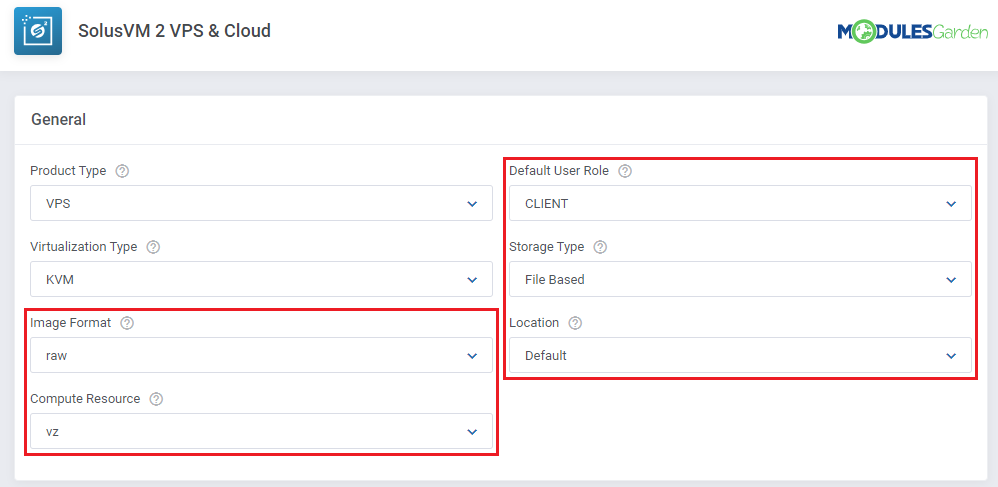
|
20. Set up the limits on the virtual machine.
For both virtualization types, these are:
- Virtual CPUs - number of virtual CPUs assigned.
- Disk Size - disk size reserved.
Note: Remember that there has to be at least 3GB of free space for the initial machine creation and at least 10GB for reinstallation.
- Memory - memory size of the virtual machine
- Additional IPv4 Addresses - additional ipV4 addresses to be added during creation.
- Additional IPv6 Addresses - additional ipV6 addresses to be added during creation.
Additionally, for the VZ virtualization type define:
- vCPU Units - this argument is used in the kernel fair scheduler. The larger the number is, the more CPU time the virtual machine gets relative to other virtual machines.
- vCPU Limit - the number of CPUs the virtual machines will be limited to. Enter '0' to disable the limit.
- IO Priority - this number determines the priority of the VM's I/O requests relative to I/O requests of other virtual machines.
- SWAP - the size of the SWAP file in MiB.
|
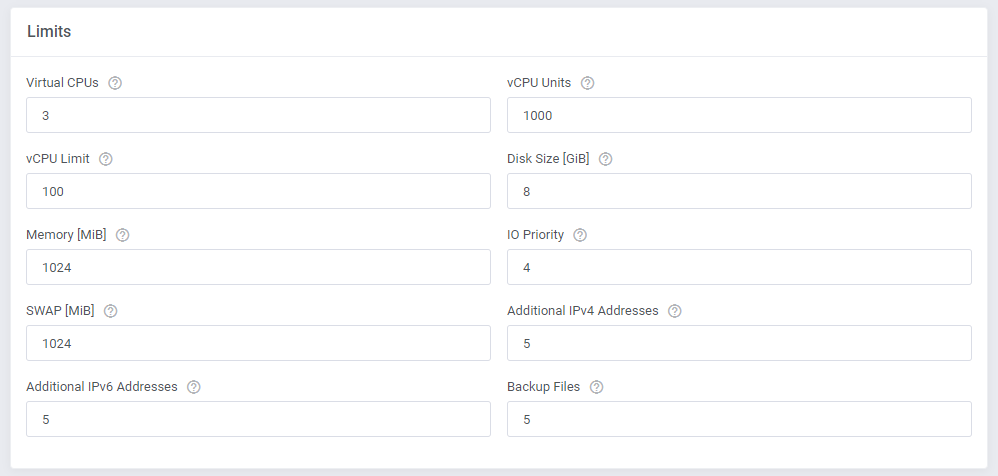
|
21. Define the default configuration.
- Enable IPv4 - decide if IPv4 protocol should be used.
- Enable IPv6 - decide if IPv6 protocol should be used.
- Operating System / Application - select the image to be used during creation.
- User Data - include any additional commands to be run during the first server boot.
Note: The commands depend on the system you choose, a list of WHMCS variables that can be used with the commands has been provided as well, e.g., $email
|
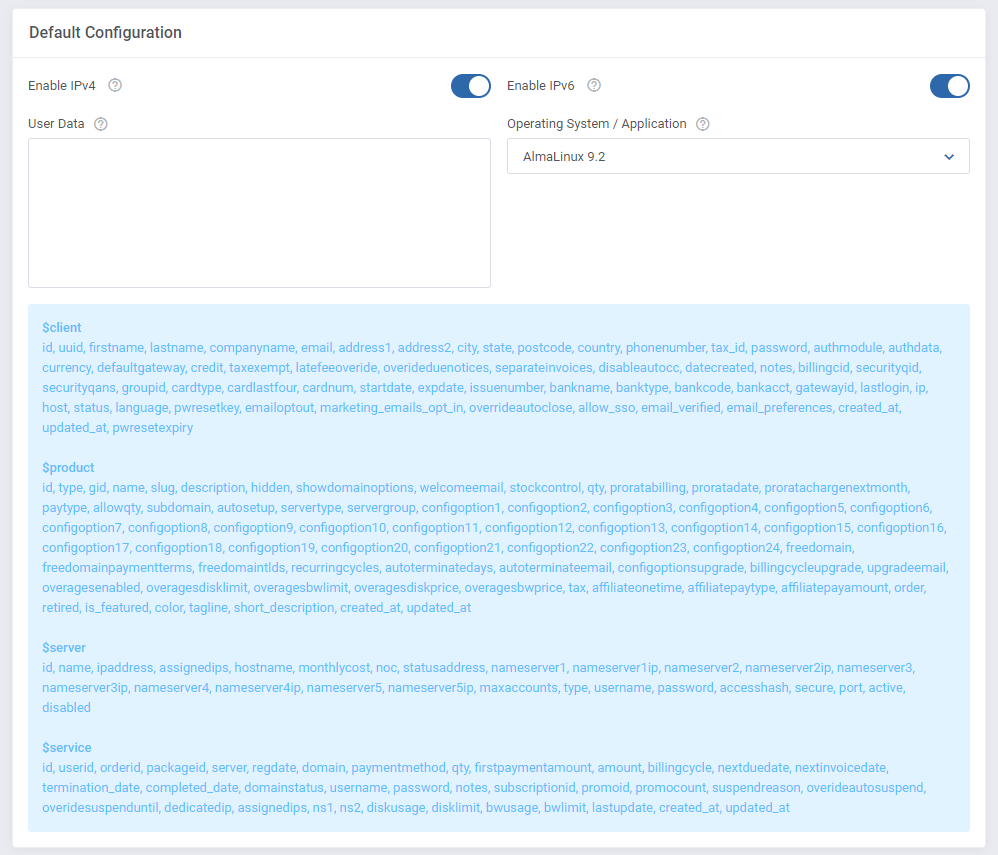
|
22. Define features available in the client area by marking them in the 'Client Area Features' section.
The functions that can be made available:
- Backups - clients will create and manage backups of their virtual machines.
- Graphs - clients will see graphs with data regarding their virtual machines.
- Network - clients will view their IP addresses, gateways, nameservers, and set networks as primary.
- Reinstall - clients will be able to reinstall their virtual machines to other systems or applications.
- Snapshots - clients will be allowed to take snapshots of their virtual machines.
Note: Snapshots can be taken on KVM virtualizations with LVM or ThinLVM storage types. If the image format is qcow2, File Based and NFS storage types can be used as well.
- Tasks - Clients will be able to see tasks performed on their virtual machines.
Images available for reinstallation:
- Available Operating Systems
- Available Applications
|
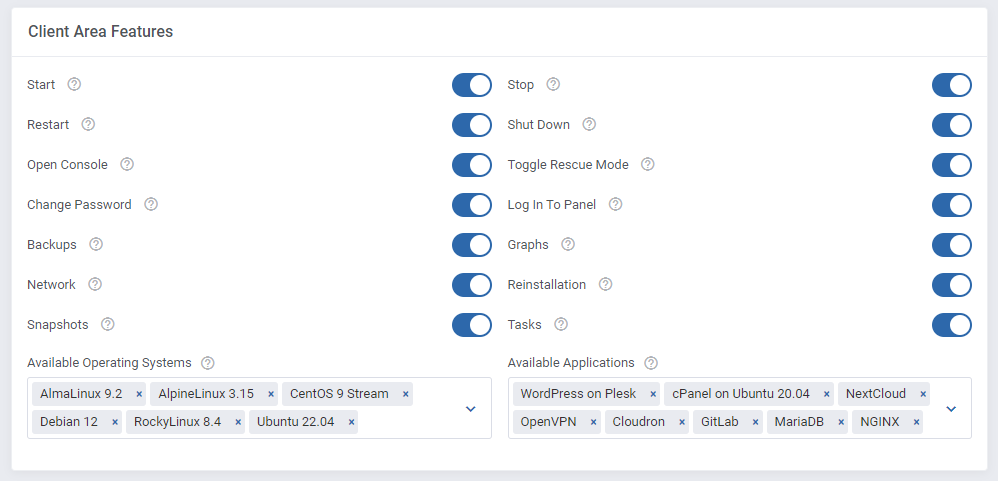
|
23. Generate default configurable options.
To do so, press 'Generate' as shown on the screen below. You can choose which options to generate. Some options only work with virtual server [VS] virtualization type.
Note: This step is optional. It is advisable not to generate options that you do not plan to use, or in case you want their fixed values to be taken from the module settings, rather than being flexible.
When you are done with the module settings make sure to 'Save Changes'.
|
24. As the last step add a cron job as shown below (5-minute intervals are recommended).
php -q /your_whmcs/modules/servers/SolusVM2VpsCloud/cron/cron.php queue
This cron makes sure tasks are run automatically when in the queue.
Do not forget to replace 'your_whmcs' with your WHMCS root location. The cron can be also executed every single minute in order to perform the action more often.
You have just finished the installation and configuration of the product, congratulations!
|
Management
You have just correctly created and customized a new product.
Let us continue to the module management. The client area, the admin area and the addon will be described in detail in this section.
|
Addon Configuration
Now we will highlight the features of the addon first.
Go to 'Addons' → 'SolusVM 2 VPS & Cloud' in your WHMCS to access it.
|
Servers
'Servers' section contains a list of your configured servers, you may quickly edit them directly from this tab, simply press the edit icon.
The information displayed in the addon includes:
- Server name
- Server IP address
- Server active accounts number and limit
- Server status
|
Click on the 'OS Images & Applications Icons' button to view a list of images available on the server.
You can change the image associated with each operating system and application by clicking the 'Settings' icon and choosing a picture from the media library.
|
Media Library
The 'Media Library' section stores images that can be used as thumbnails for your operating system and application images.
Use the Additional Actions to delete all images at once.
To upload a new image, use the 'Upload Image' button.
|
Queue
In this section, you will find a list of all the tasks issued by the module.
The information on each task includes:
- Task ID
- Related item
- Task status
- Task type
- Attempts taken
- Date of creation
- Date of the last status update
You may also use the action buttons to:
- See task details
- Manually run the task
- Delete the task
To find specific tasks use the search and sorting functions.
|
Task details include:
- Task ID
- Job
- Queue
- Retry Count
- Parent ID
- Type
- Related Item
- Custom Relation
- Status
- Retry After Date
- Created At Date
- Updated At Date
|
| Related log entries can be found in a separate tab.
|
| Tasks can also be deleted with the mass action function.
|
| Additional actions include the 'Auto Prune' system, which will automatically delete tasks after a predefined number of days.
|
Customizing language files is now extremely easy with the "Translations" tool that is now available directly in the addon.
Its user-friendly design makes managing various language file tweaks a smooth and efficient process.
Prepare translations for the original English files with this handy built-in tool. For specific instructions on how to use this tool please refer to its dedicated article, you will find it here.
|
Admin Area
VPS
Admins can monitor and manage the virtual machines on the client's page.
The action buttons include:
- Start the machine
- Stop the machine
- Restart the machine
- Access the machine's console interface
- Change the password of the machine
Underneath the information regarding the virtual machine is located, it includes:
- Status of the machine
- Hostname
- vCPUs in use
- Disk space allocated to the machine
- Operating system/application currently used
All tasks from the SolusVM 2 panel are logged in the 'Tasks' table.
The 'Queue' table lists the tasks issued by the module.
|
Cloud
Admins can monitor and manage the servers on the client's page.
The Available Resources graph displays how much of the distributed resources are in use.
The Virtual Server list features details about the client's servers and offers options to:
- Start the server
- Stop the server
- Restart the server
- Delete the server
- Access Console
and import new virtual servers.
All tasks from the SolusVM 2 panel are logged in the 'Tasks' table.
The 'Queue' table lists the tasks issued by the module.
Note: Keep in mind that the 'Suspend' module command will suspend all machines.
|
Client Area - VPS
For the VPS products, clients have access to basic actions and information regarding their virtual machine.
The basic actions include:
- Start
- Stop
- Restart
- Console
- Change Password
If enabled, additional tools will also be available to the user.
The current information about the virtual machine are displayed in the 'Information' table.
|
Backups
Users can create and manage backups in the 'Backups' tab.
To create a new backup use the 'Create Backup' button.
Once a backup is created, it can be deleted or used to restore the virtual machine state by clicking the action buttons next to each backup on the list.
|
Graphs
Clients will find visualizations of their current 'CPU Usage', 'Disk Throughput' , 'Network Throughput' and 'Memory Usage'.
By tracking VPS usage sudden and unexpected overloads can be avoided.
|
Network
The network tab contains information regarding the virtual machine's network settings.
- IP Address
- Gateway
- Primary Name Server
- Secondary Name Server
and whether a given network is set as a primary for the virtual machine.
|
Reinstall
The 'Reinstall' tab contains a list of operating systems and applications allowed for virtual machine reinstallation.
Clicking on any of the icons will initiate the reinstallation process, after a confirmation popup.
|
Snapshots
The 'Snapshot' tab allows the users to create new snapshots and manage their snapshot library.
Use the 'Create Snapshot' button to take a new snapshot.
The action buttons below can be used to restore a snapshot or delete it.
|
Tasks
The list of tasks related to the client's virtual machine can be found in the 'Tasks' tab.
The list features details such as:
- Task start time
- Task finish time
- Action
- Status
- Duration
|
Client Area - Cloud Type
The client area of cloud products features 'Available Resources' information table and the 'Virtual Servers' list.
The table features a graphical representation of the resource usage of
- vCPUs cores
- Disk limits
- Memory limits
- Additional IPv4 addresses
- Additional IPv6 addresses
Hovering over the question mark icon will display the exact numbers for each metric.
|
Action buttons allow managing, deleting, and performing actions on existing servers.
- Manage Virtual Server - opens the details page where changes can be introduced.
- Delete - starts the task of deleting the server.
- Additional Actions - allows actions such as: 'Start ', 'Stop', 'Restart' and 'Console'.
|
New Virtual Server
|
To add a new virtual server, click on the 'Create Virtual Server' button first.
|
Then provide the configuration for the new virtual server.
- Name
- Description
- Password
- vCPUs
- Disk Size
- VS RAM
- Primary IPv4
- Primary IPv6
- Additional IPv4
- Additional IPv6
- Image
The graph on the top of the screen can help you see how many resources remain while you allocate them to the new server.
Click on 'Submit' when ready.
|
Tips
1. Since the SolusVM 2 panel only allows a small number of special signs to be used in passwords, it might be helpful to disable special characters in auto-generated passwords.
To do so, navigate to 'General Settings' → 'Security' → 'Auto Generated Password Format' and select 'Generate passwords containing a combination of letters and numbers only'.
|
Update Instructions
An essential guidance through the process of updating the module is offered here.
Ensure successful completion of the module update by carefully following each step, thereby preventing data loss or any unforeseen issues.
Additionally, you will find a current list of supplementary actions necessary for a smooth update process there.
|
Upgrade Guide
Seeking a solution that offers greater flexibility, customization tailored to your precise needs, and unrestricted availability?
There is an option that not only proves to be cost-effective in the long run but also includes prioritized support services, making it a truly valuable investment.
Opt for the Open Source version of your SolusVM 2 VPS & Cloud For WHMCS module to unlock these benefits.
Simply click on either the Get Source Code or Upgrade To Lifetime button found on the product's page in our client area to complete the one-step upgrade process, with a dedicated discount already applied.
Follow a comprehensive guide covering the transition process, the advantages it brings, and step-by-step instructions on what to do next after the order has been successfully finalized.
|
Common Problems
| 1. When you have problems with connection, check whether your SELinux or firewall does not block ports.
|
